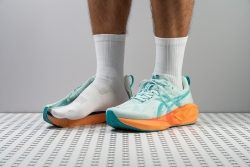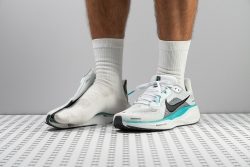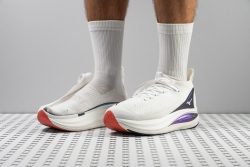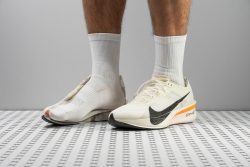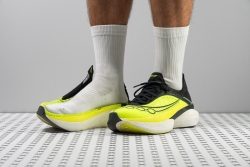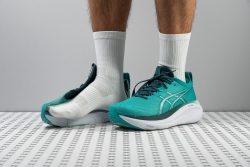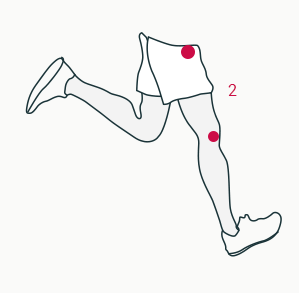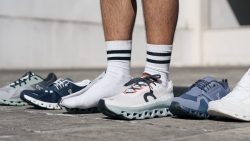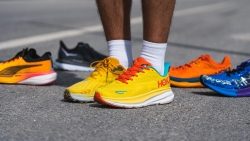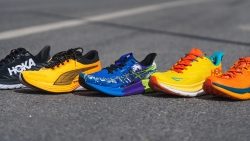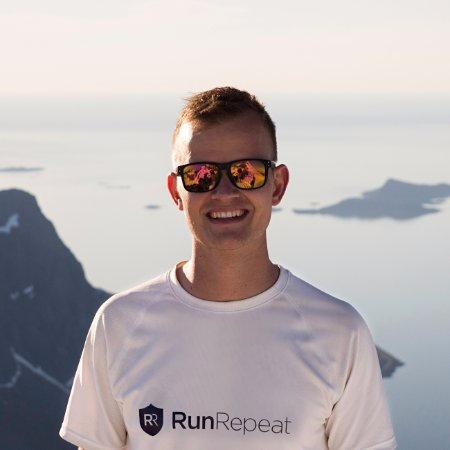7 Best Running Shoes in 2025
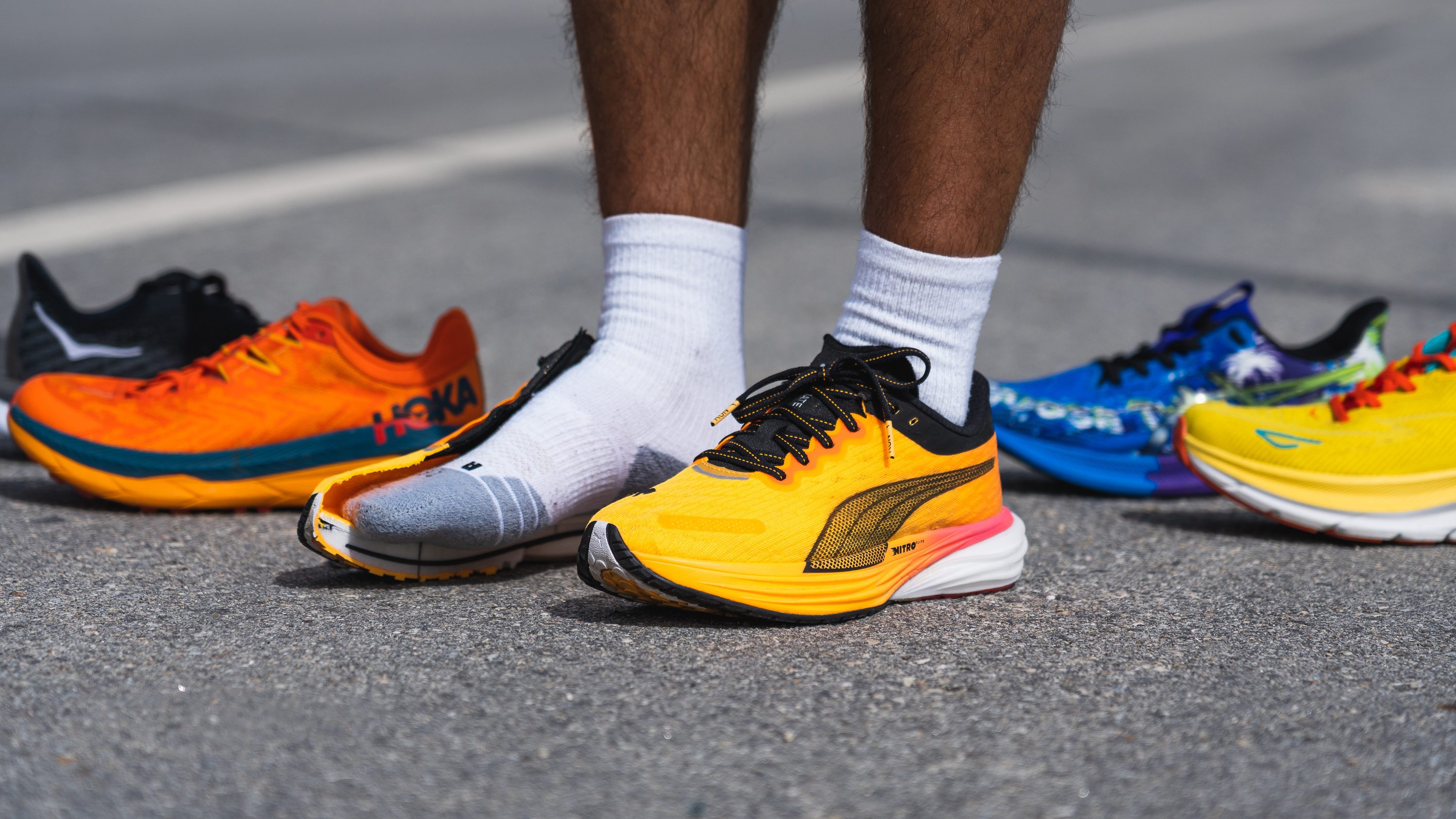
We buy shoes ourselves. We earn commissions when you buy through us, at no extra cost. Why trust us
Are you looking for a comfortable all-arounder? A supportive shoe for overpronation? Or a speedy racer for a new personal best? There is no ONE best shoe for everybody.
We ran in these running shoes and tested them in our lab to help you find the best pair. See our highly recommended models in several categories below.
And if you want to learn more about choosing the right running shoe, scroll down to our in-depth guide.
How we test running shoes
We focus on delivering objective running shoe reviews, and we're able to do that because we not only run in the shoes but also twist them, fill them with smoke, cut them in half, put them in the freezer, and perform dozens of standardized tests in our lab.
Here's what our workflow looks like:
- As an independent shoe testing lab, we purchase all shoes with our own money to stay unbiased.
- We run in the shoes and make sure that we vary our runs from roads to trails and from recovery runs to sprints before submitting our in-depth reviews.
- We cut shoes into pieces and measure over 30 parameters on shock absorption, energy return, traction, durability, breathability, stiffness, stack heights, platform width, insole thickness, and more.
Best running shoes overall
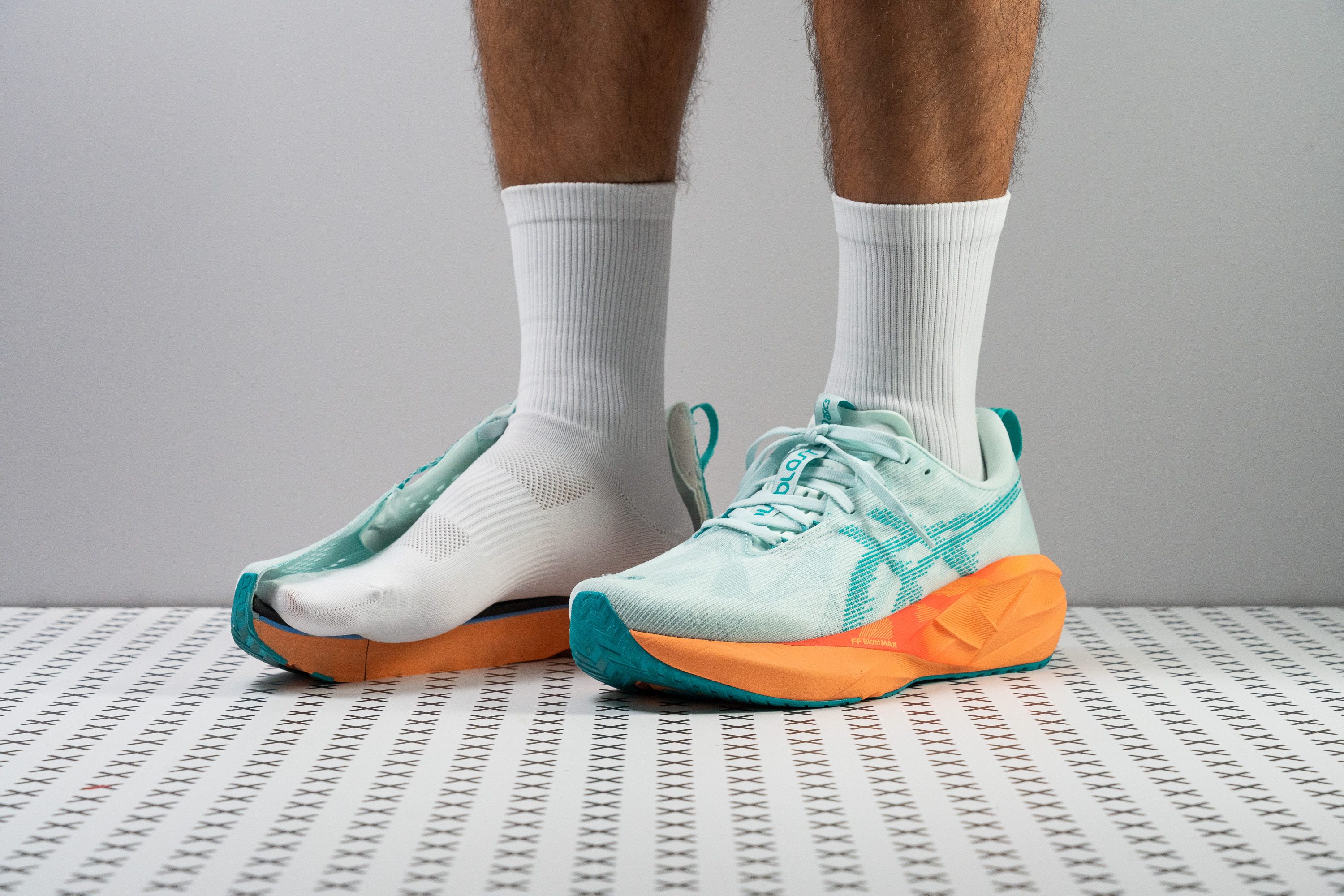





















































What makes it the best?
The Novablast 5 stands out in the all-rounder game, bringing a whole new level of comfort while sustaining stability, responsiveness, and reliable durability. Novablast 5 repeatedly excels in our lab tests and outdoor runs, rightfully claiming its throne as the ultimate running shoe.
Indulging in this shoe is an absolute delight. The ultra-stacked 40.9/33.5 mm midsole is our main star as it oozes divine levels of comfort for double-digit miles. Our durometer confirmed our sensations, as it measured 38.4% softer than average. Despite its plush nature, the cushion brings out a vibrant ride for faster days.
Our runs feel stable regardless of our pace. Novablast 5 offers an extra width of 8.3/6.9 mm in the forefoot and heel to ensure we land securely no matter our foot strike. We can run mindlessly as the midsole flows with our movements. Our scales confirm it’s a light 9.0 oz (254g) while our flex test validates it’s 32.2% more adaptive than average.
Novablast 5 proves its durability as the midsole had minor creasing and the outsole barely had scratches after long miles of running against hard pavements. We didn’t feel any difference in terms of performance, showing it’s a reliable and long-lasting running partner.
However, its shine fades on wet pavements because of its lack of traction. Those who prioritize relentless grip should look elsewhere.
Pros
- Improved energy return with FF Blast MAX foam
- Plushiest foam in a Novablast yet
- Keeps the same price as v4
- Higher stack height for extra cushioning
- Enhanced flexibility
- Lighter than its predecessor
- Best Novablast ever for wide feet
- Exceptional weight-to-cushion balance
- Works for short, medium and long runs
Cons
- Breathability could be improved
- Toebox durability
Best daily training running shoes
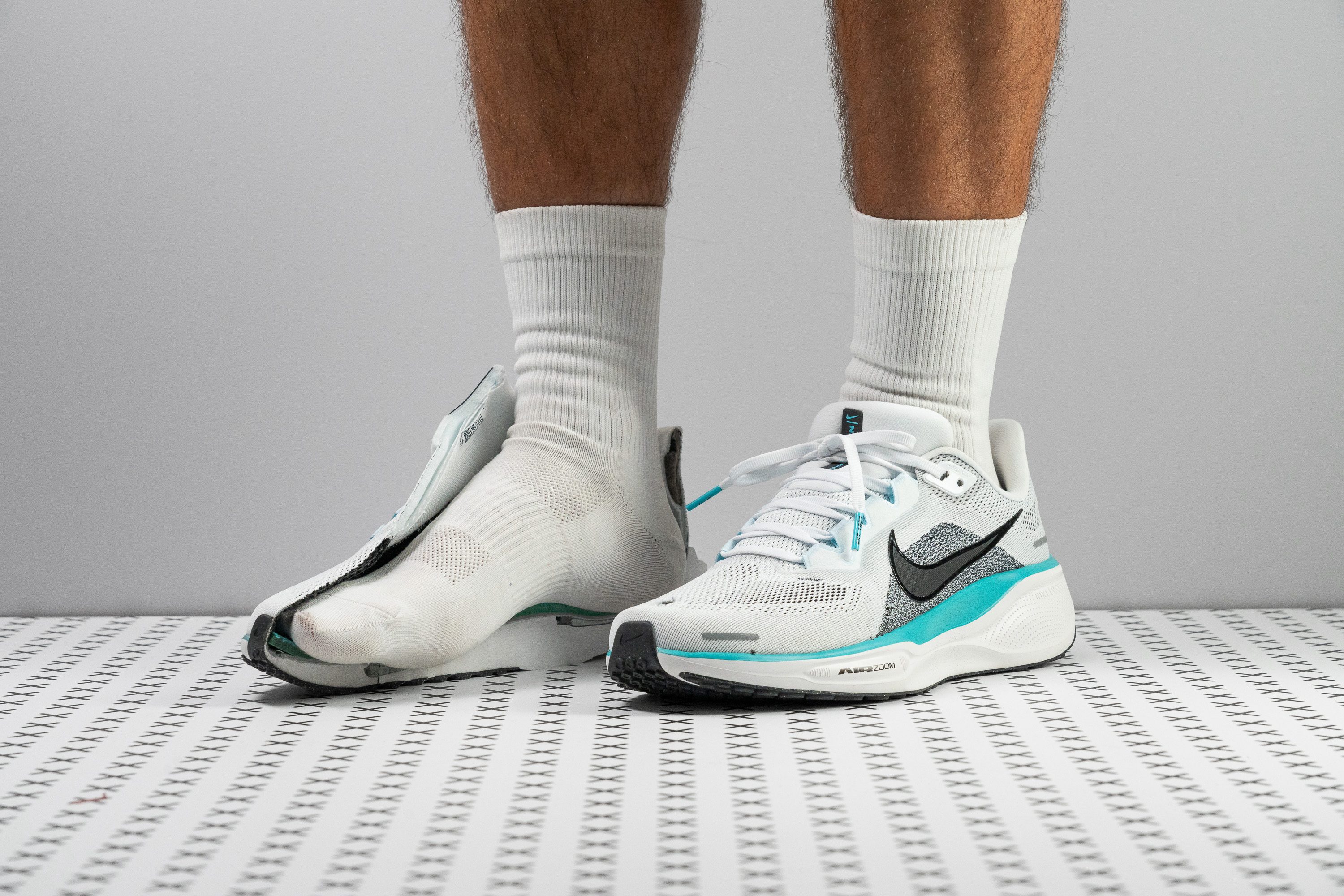

























































What makes it the best?
The Pegasus series did not disappoint with its 41st version, dropping the ultimate daily trainer that both newcomers and seasoned runners will appreciate alike. It maintains its liberating ride in our runs and comes out with an all-new ReactX foam that’s both plush and energetic. Plus, our lab confirms its upper is the perfect blend of comfort and breathability.
One of Pegasus 41’s highlights lies in the midsole design. Boasting two Air Zoom units nestled within the ReactX foam, it launches our toe-offs with ease and catches us with gentle landings. As confirmed by our durometer, it’s 26.2% softer than average.
The shoe is bendable in all directions, which keeps the pleasant natural running experience. As proven by our bend test, it is 34.0% more flexible than average. Even twisting the shoe in our manual assessment felt effortless with its 2/5 rating.
Even the upper felt liberating with its unhampered airflow, which we found quite surprising given its soft touch and dual-layer mesh. True enough, our smoke test highlights its impressive ventilation with a 4/5 breathability rating.
However, Pegasus 41 has a steep 11.4 mm drop which may feel too harsh for mid-to-forefoot strikers. We believe this pair is more suitable for heel strikers.
Pros
- Enhanced for heel strikers
- New ReactX foam!
- Improved breathability
- Plush upper
- Good durability
- Several stability enhancements
- Newly designed rocker and bevel
- Solid performance
- Superior lockdown
- Sustainable features
Cons
- Price increased by $10
- Worse than the v40 in cold temperatures
- Poor grip
Best stability running shoes














































What makes it the best?
The ASICS Gel Kayano is known as a top-stability running shoe, and the 32nd version is no different. Backed up by our road runs and lab tests, it seamlessly blends velvet comfort and steady support into one—qualities that boost our confidence and happiness like no other.
The GK32 integrates subtle elements to guide our foot alignment. The main star is the 4D Guidance System, which is composed of soft foam under our arch to deliver custom support to each unique individual. Additionally, the shoe has sidewalls and a vast landing base that secures our landings safely. Our jaws dropped at the mega 119.8/97.2 mm midsole vs. the 114.3/90.7 mm average, making it less likely to lose our balance.
Moving to the cushioning, it impressed us greatly with the heavenly comfort it delivers. Not only is the heel extra high at 39.9 mm, but it also includes the PureGEL technology to create pillowy landings. Our lab test confirms it is indeed a shock-absorbing powerhouse with a high 133 SA rating in the heel.
Another standout feature is its ASICSGRIP rubber. At 0.84, it recorded one of the highest scores in our traction test, indicating reliable grip across wet and dry seasons.
To our disappointment, the ride feels underwhelming. With a confirmed low energy return in lab tests, we can’t recommend GK32 to runners seeking fast performance.
Pros
- Amazing shock absorption
- Plush and breathable upper
- Made to last
- Dependable for most pronators
- Heavy-duty outsole with excellent grip
- Stable as a table
- Pillow-soft heel padding
- Improved fit
- Excellent build quality
Cons
- Not for soft-foam lovers
- Bad energy return
- Overpriced in Europe
Running shoes with the best shock absorption

















































What makes it the best?
The Mizuno Neo Vista 2 offers next-level comfort with its skyscraper stack and leg-saving properties. Through extensive testing in the lab and repetitive pounding on the pavement, we confirmed its excellent joint protection and smooth ride, rightfully claiming its title as the running shoe with the best shock absorption.
As we effortlessly log miles, the Neo Vista 2 erases any harshness of landing impact, courtesy of its gigantic 46.0/37.5 mm stack height. It tops the charts in terms of height and impact protection! In our shock absorption test, it scored 170 SA in the heel and 137 SA in the forefoot, the highest we’ve recorded so far.
We melted into the midsole's forgiving and refreshing ride. Despite its thick stack, it surprisingly feels light and effortless. Our scales confirm it weighs 9.3 oz (264g), at par with the average and lower-stacked shoes. Plus, it emerged 10.0% more malleable than average in our bend test.
However, the midsole felt uninspiring, which shows Neo Vista 2 prioritizes comfort over performance. Those looking for a trainer capable of faster efforts should try other options.
Pros
- Massive stack height
- Super-plush Enerzy NXT foam
- Perfect for long runs
- Lightweight for its huge size
- Good durability
- Breathable knit upper
- Roomy toebox height
- Insanely fun!
Cons
- Not enough energy return
- Price hike feels unjustified
- Not stable for heel strikers
Best race running shoes
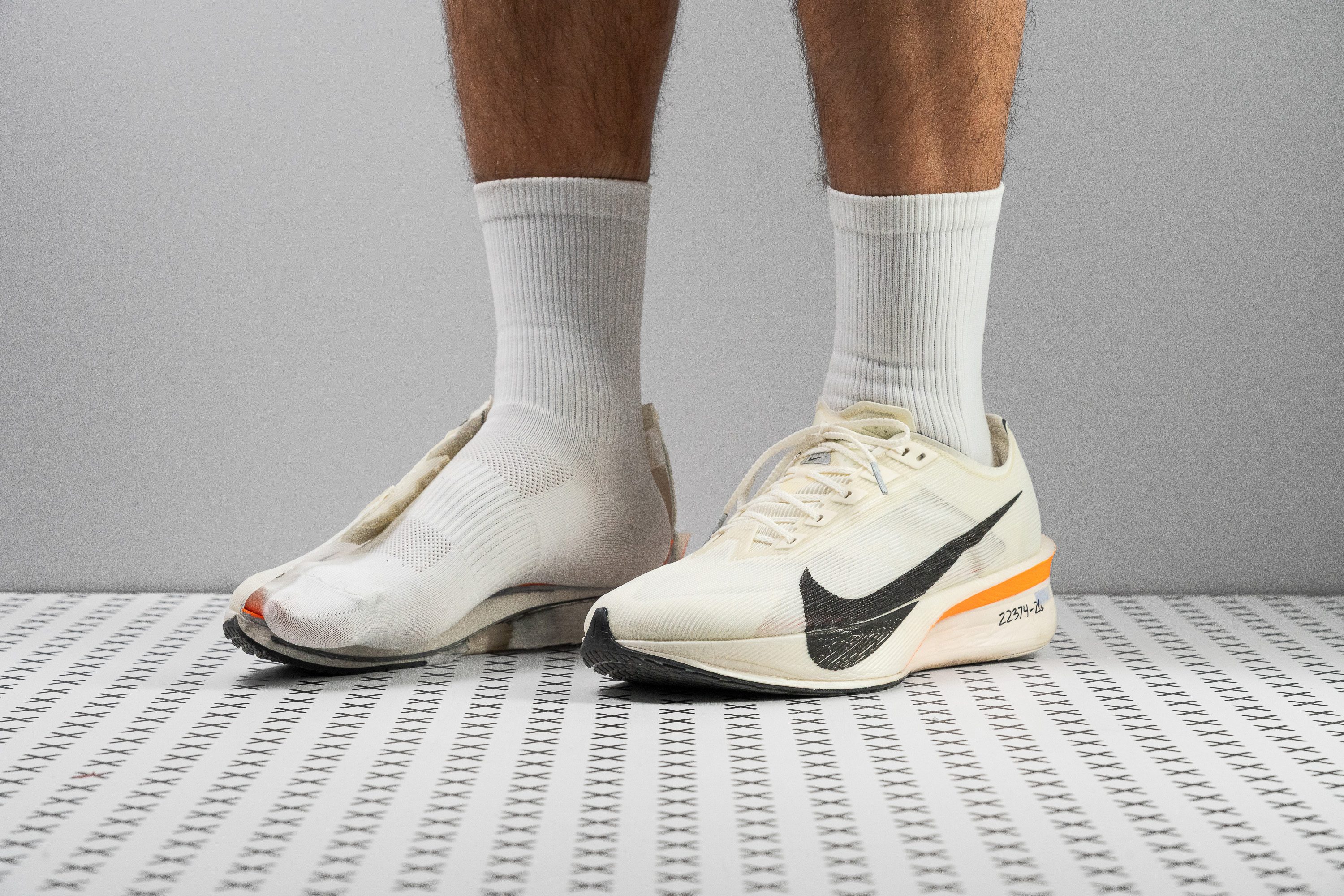





















































What makes it the best?
After going through hundreds of shoes in the lab, the Nike Vaporfly 4 caught our attention as the ultimate racer, perfect for PB chasers. During runs, it ignited our every stride without overlooking the comfort required for longer races. With its unmatched energy and lightness, we unleashed speed like no other.
We’re amazed how V4 managed to keep its build at an ultra-light 5.6 oz (166g) with all its features. For reference, its plated counterparts average 7.3 oz (208g). Regardless of foot strike, we have tons of impact protection and boundless energy from the soft 19.9 HA ZoomX midsole.
V4 elevates its FlyPlate in the forefoot by making it spoon-shaped to encourage faster leg turnover. This helps sustain our speed with less effort. It releases power through its insane stiffness, which our bend test shows is 14.6% more, and therefore snappier, than average. We felt that V4 shined best at our race pace.
The upper is a summer runner’s dream, allowing air to flow in and out freely while providing protection. On our breathability and Dremel tests, it earned a remarkable 4/5 in both tests—no need to worry about hotspots, sweaty feet, or torn uppers.
However, its reduced stack height vs. previous versions makes it less suitable for heavier runners. Those who need more cushioning will not be satisfied with this pair, especially for marathon distances.
Pros
- 13% lighter than the Vaporfly 3
- Awesome for 5K, 10K and 21K races
- Full ZoomX midsole
- Spring-loaded carbon-fiber Flyplate
- Fantastic lockdown with premium laces
- Moderate rocker for a more natural ride
- Improved perforated, removable insole
- Better rubber coverage in the forefoot
- Gets improvements from the Alphafly 3
- Great upper featuring breathability and durability
Cons
- Less ideal for marathon racing
- Still lacks the snappy feel of the Vaporfly 1&2
- Narrow midfoot and heel limit stability
Running shoes with the best energy return
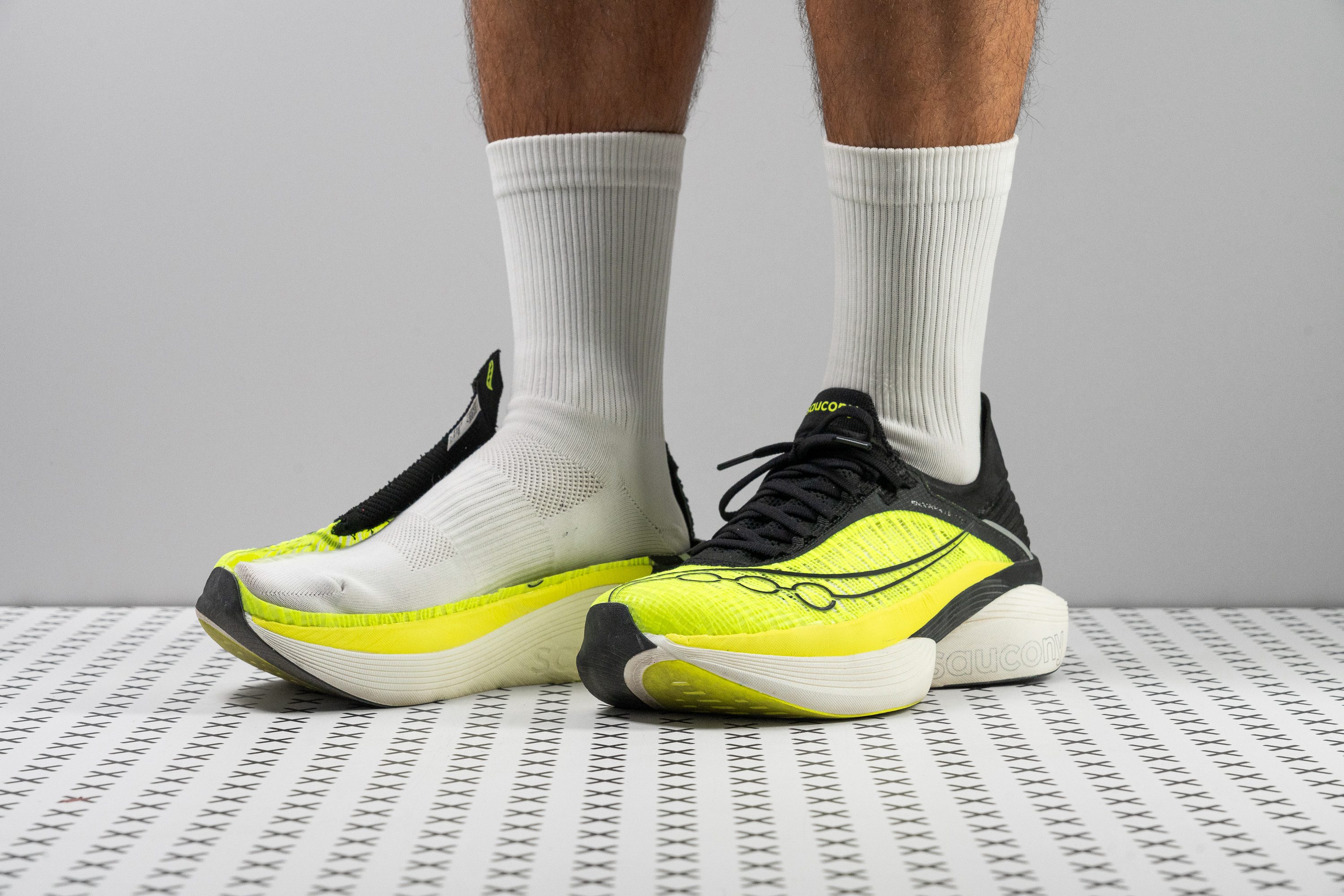















































What makes it the best?
After miles of pounding the pavement, we found the Saucony Endorphin Elite 2 seamlessly combines power, traction, and comfort into one. It delivers all the elements needed to overcome all sorts of fast workouts, backed up by its shattering records in the lab. Therefore, it’s our ultimate running shoe with the best energy return.
There’s no other way around it, EE2 fuels our need for speed. The midsole includes a carbon plate, encased in the IncrediRUN foam, which acts as a powerful propeller to help us push our limits. Testing for energy return, the heel emerged with a massive 80.6%, while the forefoot at 82.1%, both the highest we’ve ever seen in the lab!
Teaming up with speed is a platform that offers exceptional impact protection, much to our delight since carbon-plated shoes may feel overwhelming at times. With exceptional levels of shock absorption, 157 SA in the heel and 123 SA in the forefoot, our legs were preserved until the final miles of our runs.
The outsole delivered exceptional traction in our runs regardless of the weather. We’re able to sprint through corners with ease and control, confirmed by our traction test with an impressive 0.48 score.
However, the soft cushioning of EE2 demands good form. We encourage those with overpronation to find a more supportive shoe to avoid injuries.
Pros
- Record-breaking energy return
- Ultra-plush foam
- Fantastic shock absorption
- Addictively bouncy and fun feel
- Ideal for the marathon distance
- Durable and breathable upper
- Improved lockdown with knit tongue
- Stack height maxes out the legal limit
- Explosive, forward-driving ride
Cons
- A touch heavy for being an elite supershoe
- Budget-crushing price
- Lateral stability is extremely bad
- Lacks specific support for heel strikers
Running shoes with the best traction
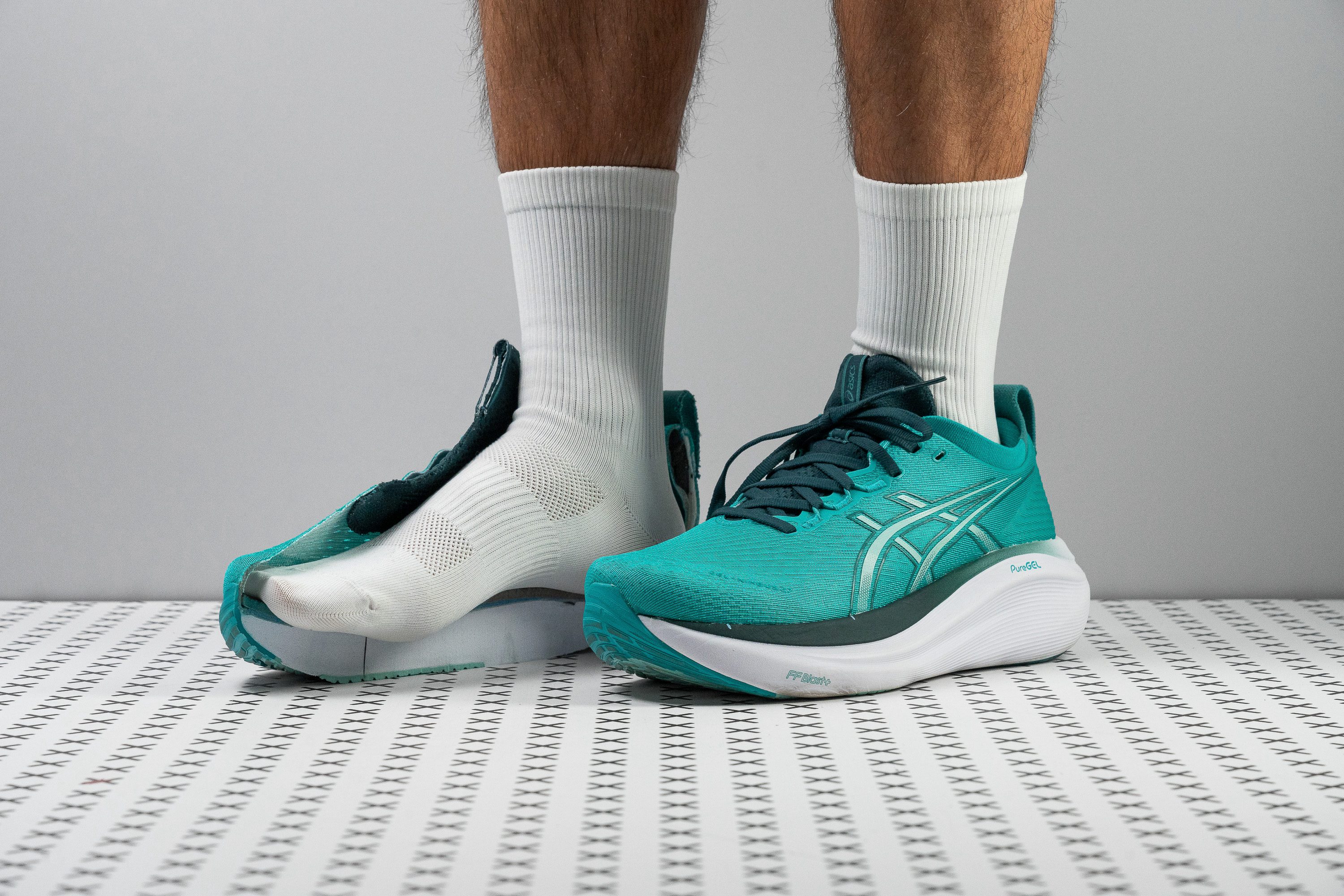
















































What makes it the best?
Running in the ASICS Gel Nimbus 27 means controlled strides because of its next-level grip leading the pack; no doubt it’s our running shoe with the best traction. Lab results reveal the shoe’s leg-saving cushioning and breathable upper, solidifying it as a gentle soul that our feet adore.
Even as we passed through wet streets, the Nimbus 27’s Hybrid ASICSGRIP kept us safe and sound. Testing further in the lab, we recorded an impressive 0.84 score, meaning it delivers 82.6% stronger grip than standard.
Beneath our feet is a divine cushion that blends height and strain-reducing properties. Our caliper shows a massive stack height of 42.7/34.4 mm, while our shock absorption test reveals a high 136 SA rating for both the heel and forefoot. Its above-average rating proves it significantly reduces the impact of repetitive landing on our legs.
We felt spoiled from every angle, with its soft, breathable jacquard mesh upper embracing our feet. It excelled in our smoke test with an above-average 4/5 breathability rating, making it comfortable across seasons.
However, the ride feels flat, so we can’t recommend this pair to those looking for high performance.
Pros
- Even more foam underfoot!
- Premium-feel, breathable upper
- Fantastic stability
- Improved toebox with extra wiggle room
- Flexible knit tongue
- True maximalist comfort for recovery runs
- Amazing heel lockdown
- Top-tier grip
Cons
- Feels bulky and heavy
- Minor price increase
- Lacks energy return
There is no ONE best running shoe
All feet are unique and even some of the best-rated running shoes might not work for you specifically.
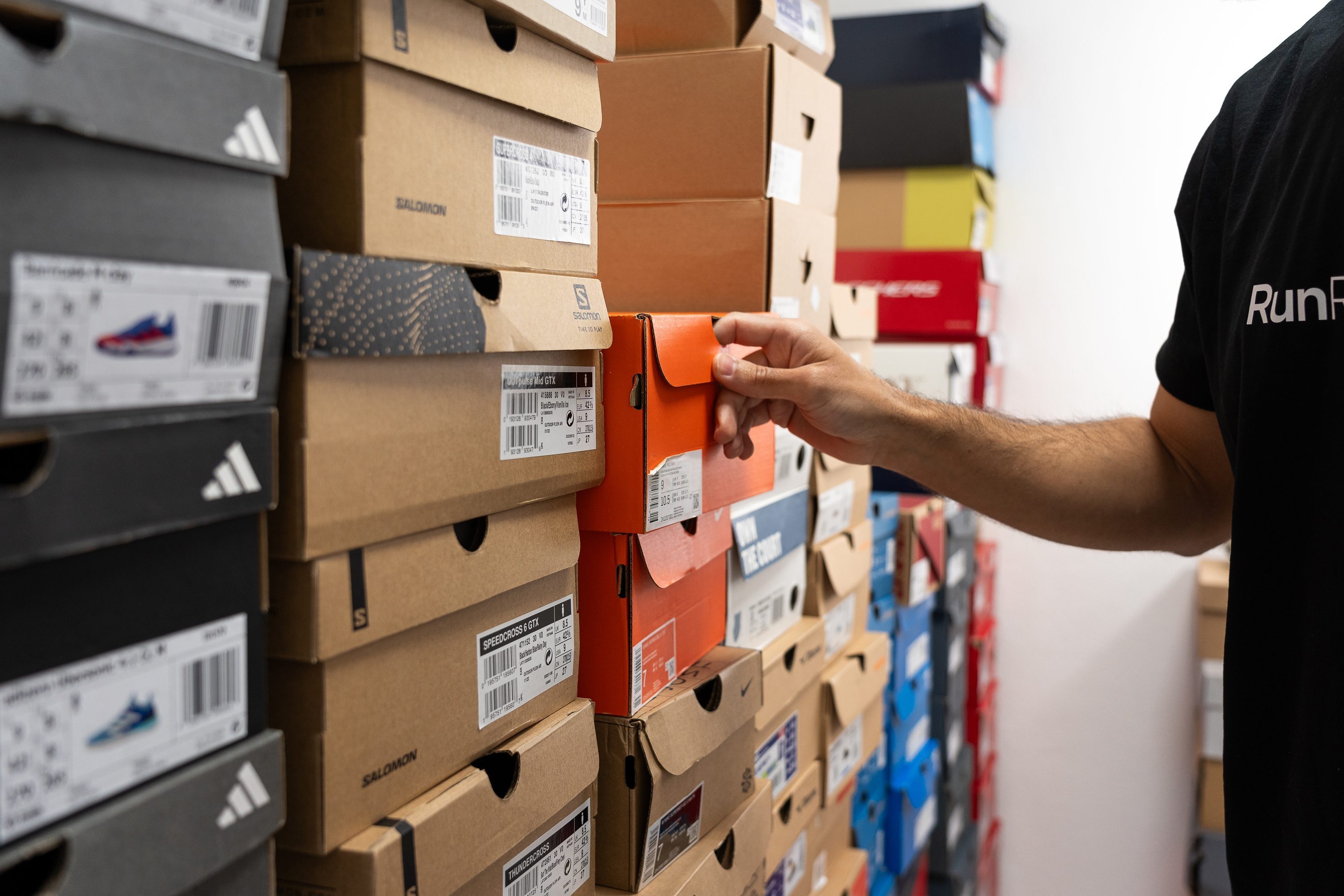
But the good news is that the running footwear market is so saturated that you are sure to find a shoe that would feel tailor-made for your feet!
In this guide, we break down the most important considerations to help you narrow down the choices and find that perfect pair.
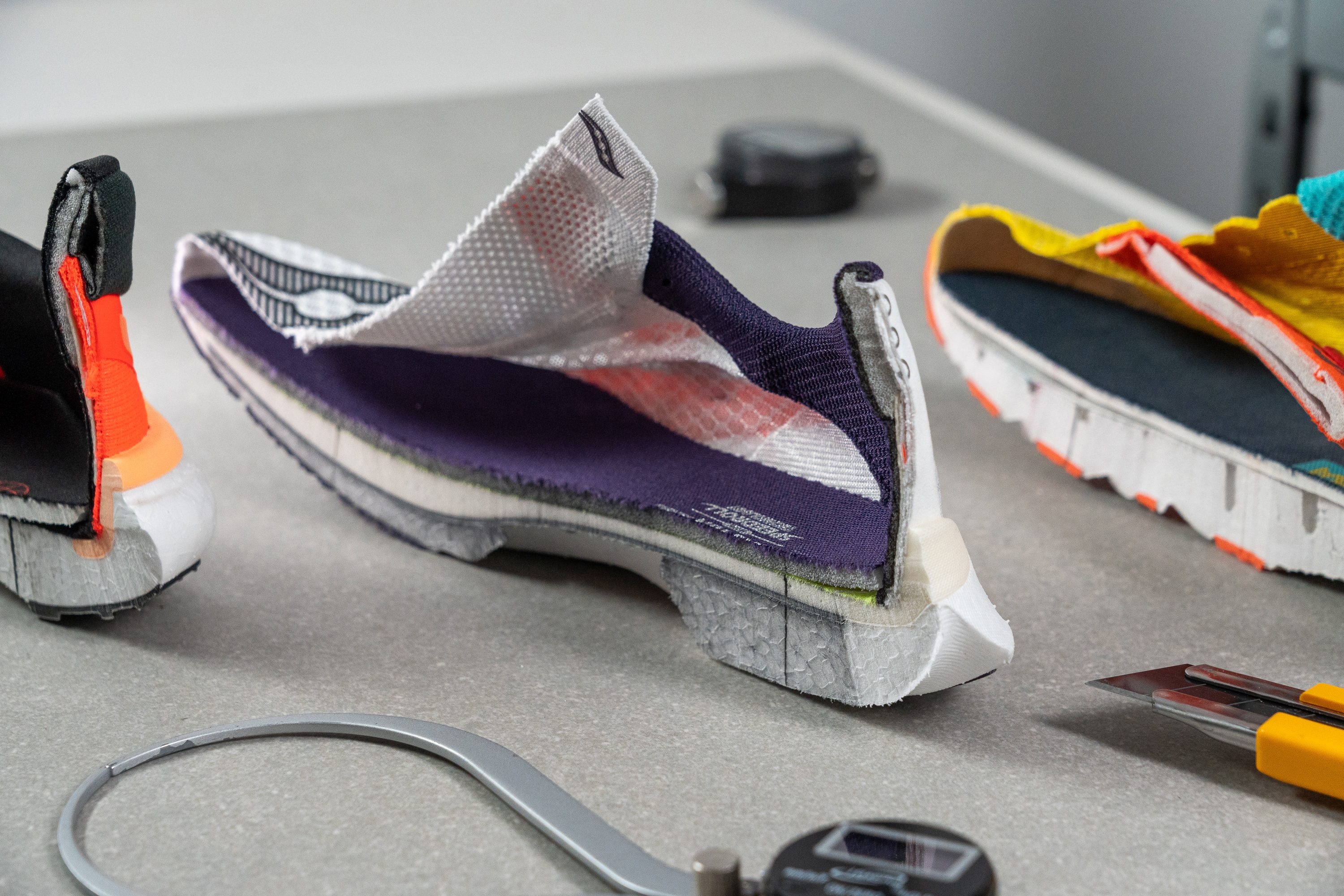
Where to start: road vs. trail running shoes
This one is simple: If you mostly run on asphalt, tarmac, treadmill, 4x4 road, or even major forest trails or the likes, then buy road running shoes.
Only buy trail running shoes if you run on single trails or off trails. Otherwise, you don’t need them.
Road running shoes
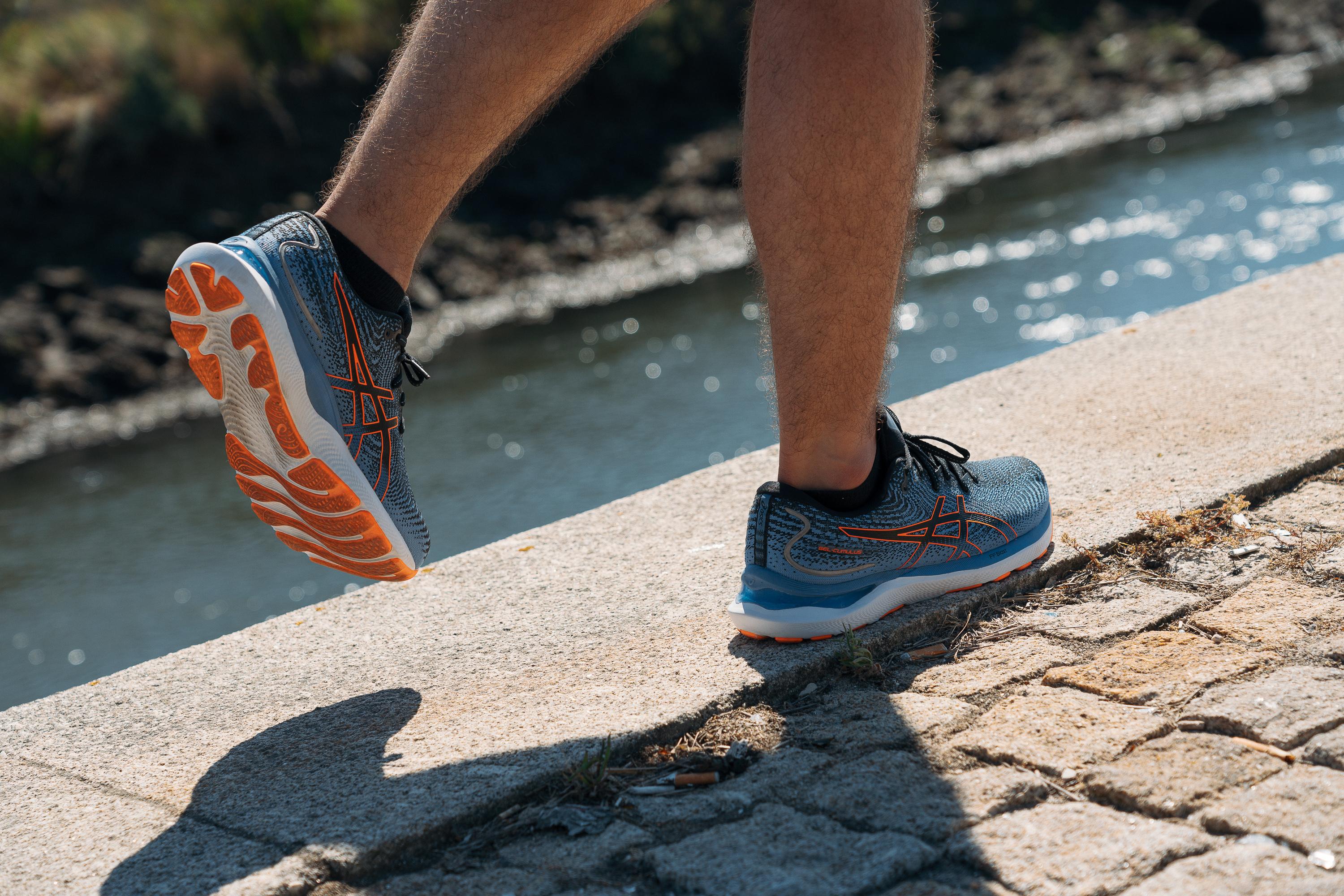
Some road shoes can also be used for light-to-moderate trails. Just make sure that they have thick and sturdy rubber outsoles.
Outsole durability shows how deep the damage was caused by 18 seconds of drilling the shoe’s rubber with a Dremel at 10K RPM speed:
Trail running shoes
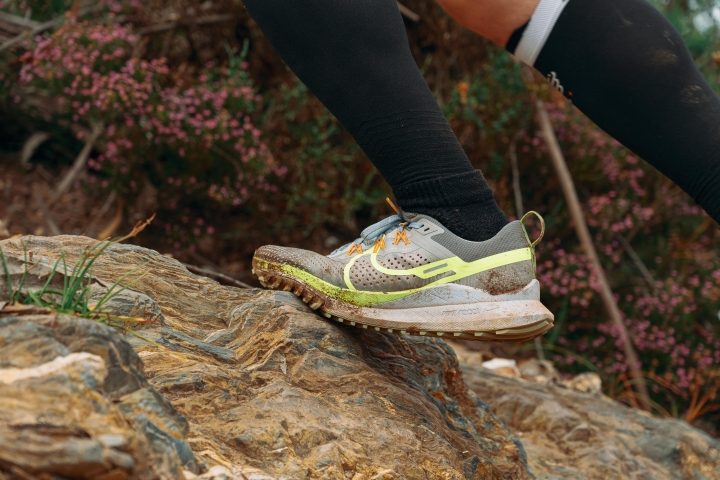
You should not be afraid to run on roads with your trail running shoes once in a while. Quite often, you’d need to run up to a mile before you get to your nearest trail, and that is not a problem. However, we recommend that you keep it at a minimum as feet and knees can start to hurt.
The bigger the lugs, the sooner your feet will start hurting. For road-to-trail shoes, lugs below 3 mm are best.
If, on the other hand, you mostly run off trails, in the wild, with mud caking up under your feet within minutes, you must get a trail shoe with deeper lugs. They will keep you surefooted by biting into the ground more aggressively. They also tend to be more spaced-out to shed off the mud while running.
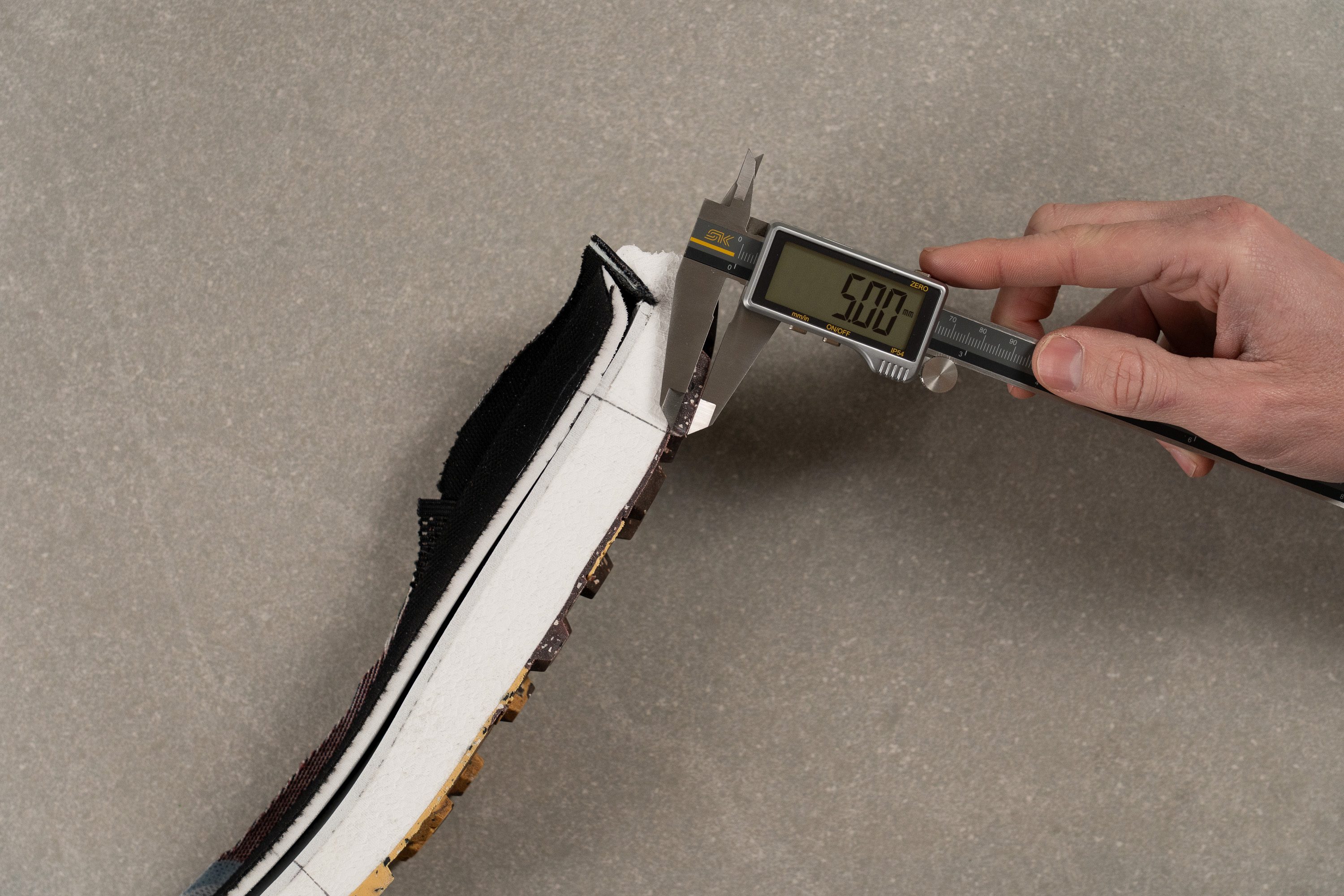
Key differences between road and trail shoes
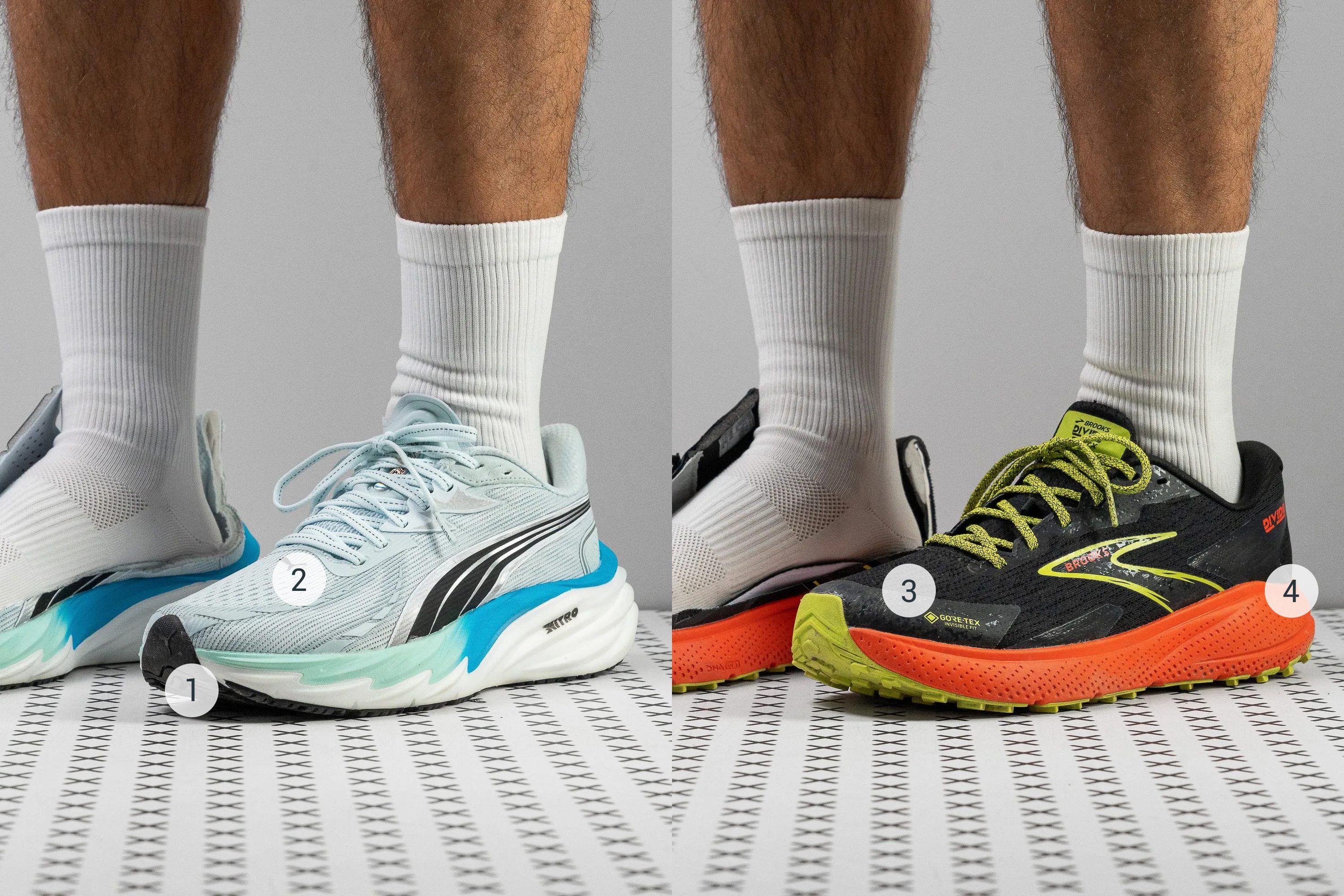
Outsole: Road shoes have flatter and pavement-ready soles. Trail shoes have lugs (tread patterns), for better traction on uneven terrain.
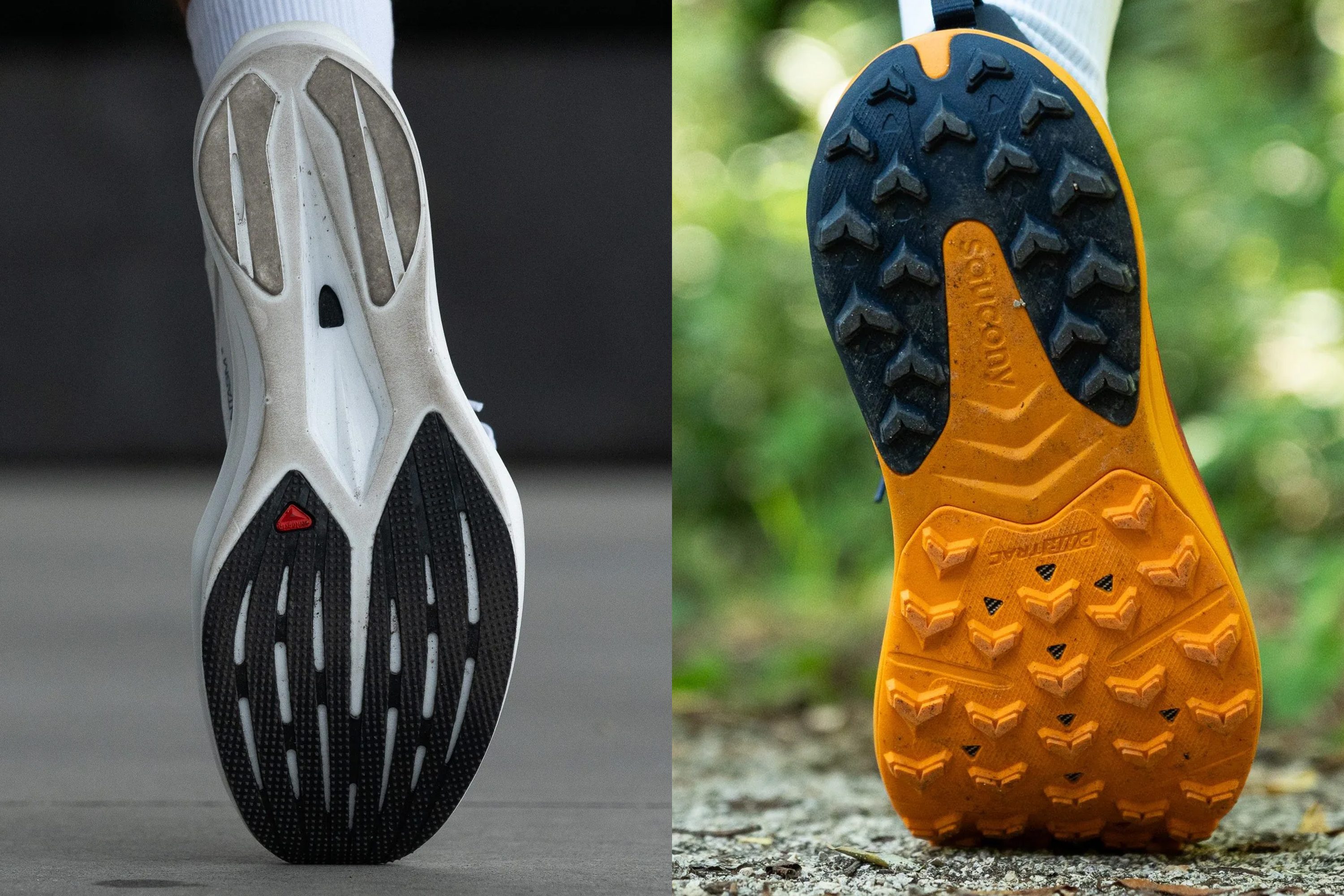
Protection: Most trail shoes are equipped with rugged toe bumpers and rock plates to keep the runner’s feet protected from various terrain challenges.

Weight: Because of the added ruggedness and protection, trail shoes are, on average, an ounce heavier than road shoes.
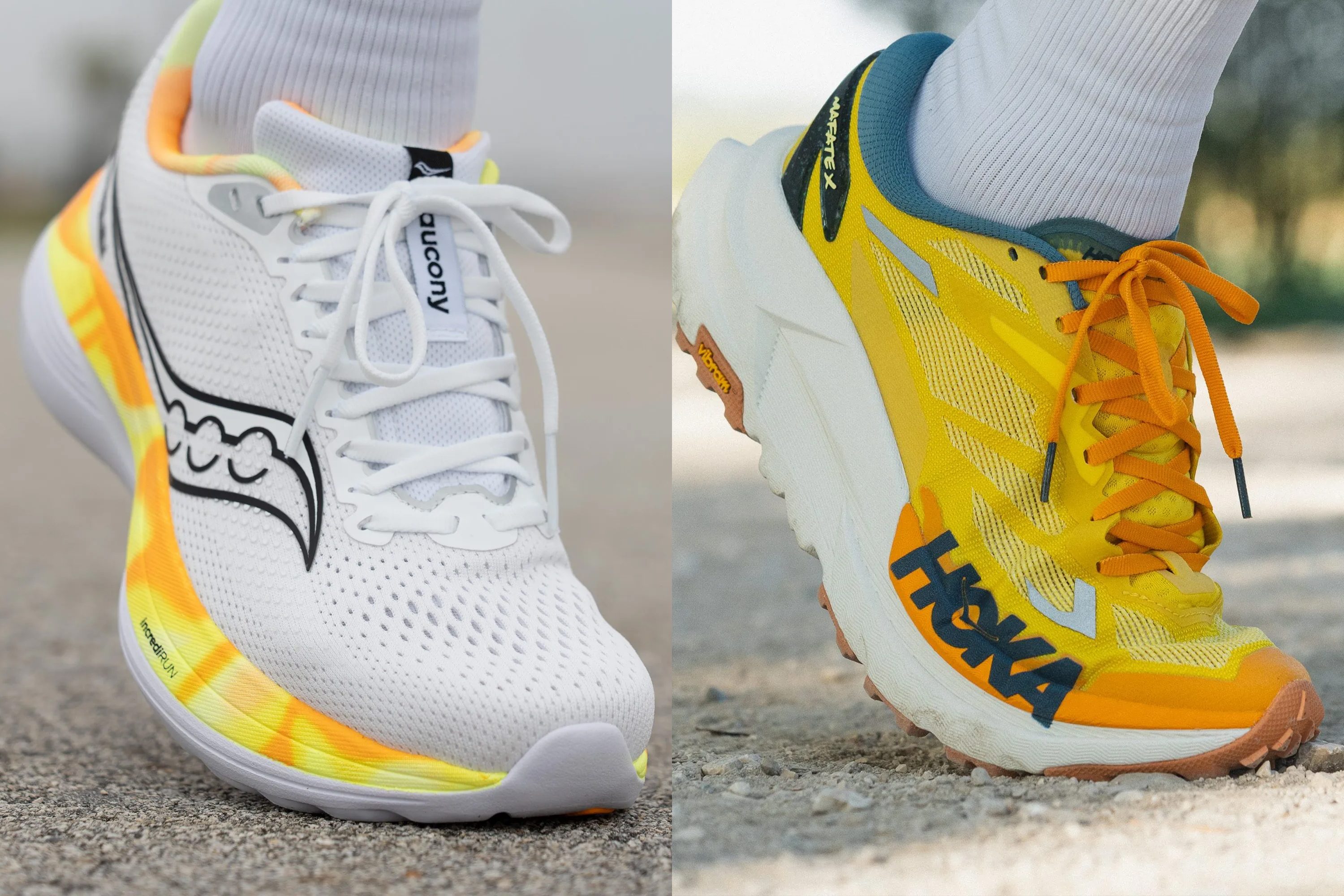
Upper: Road shoes have lighter, more breathable uppers because road races don’t have any obstacles. Trail shoes are reinforced with various protective elements, including additional layers in high-wear areas and gussets (tongue is connected to the sides), which makes them less breathable.

Based on our in-house ventilation tests, the average breathability score of road shoes is 4 out of 5, while the average of trail shoes is 3 out of 5.
Use: The most important factor
A beginner-friendly trainer is going to be vastly different from a carbon-plated marathon race shoe. Let’s take a closer look at the main running shoe categories based on their intended use.
Daily running shoes (also best for beginners and daily wear)
Well-cushioned and comfort-loaded, daily trainers make up the majority of running shoes on the market. This is where you find that go-to daily beater that never fails.

We highly recommend shoes from this category to beginner runners as they meet the following criteria:
- well-cushioned (at least 30 mm of heel stack)
- average heel-to-toe drop (8-14 mm, ideal for a beginner’s heel-striking pattern)
- medium-to-high shock absorption (110 SA or more)
- no carbon plates or aggressive rockers
- MSRP of $140 or less
Can you wear daily running shoes for everyday use? Absolutely! The characteristics mentioned above make this footwear category ideal for spending long hours on your feet.
Some daily trainers have features of speed-oriented shoes. These are more expensive but let you have two pairs in one.
Tempo/speed training running shoes
Lighter than daily trainers, this category is better equipped for picking up the pace or even setting a new speed record.
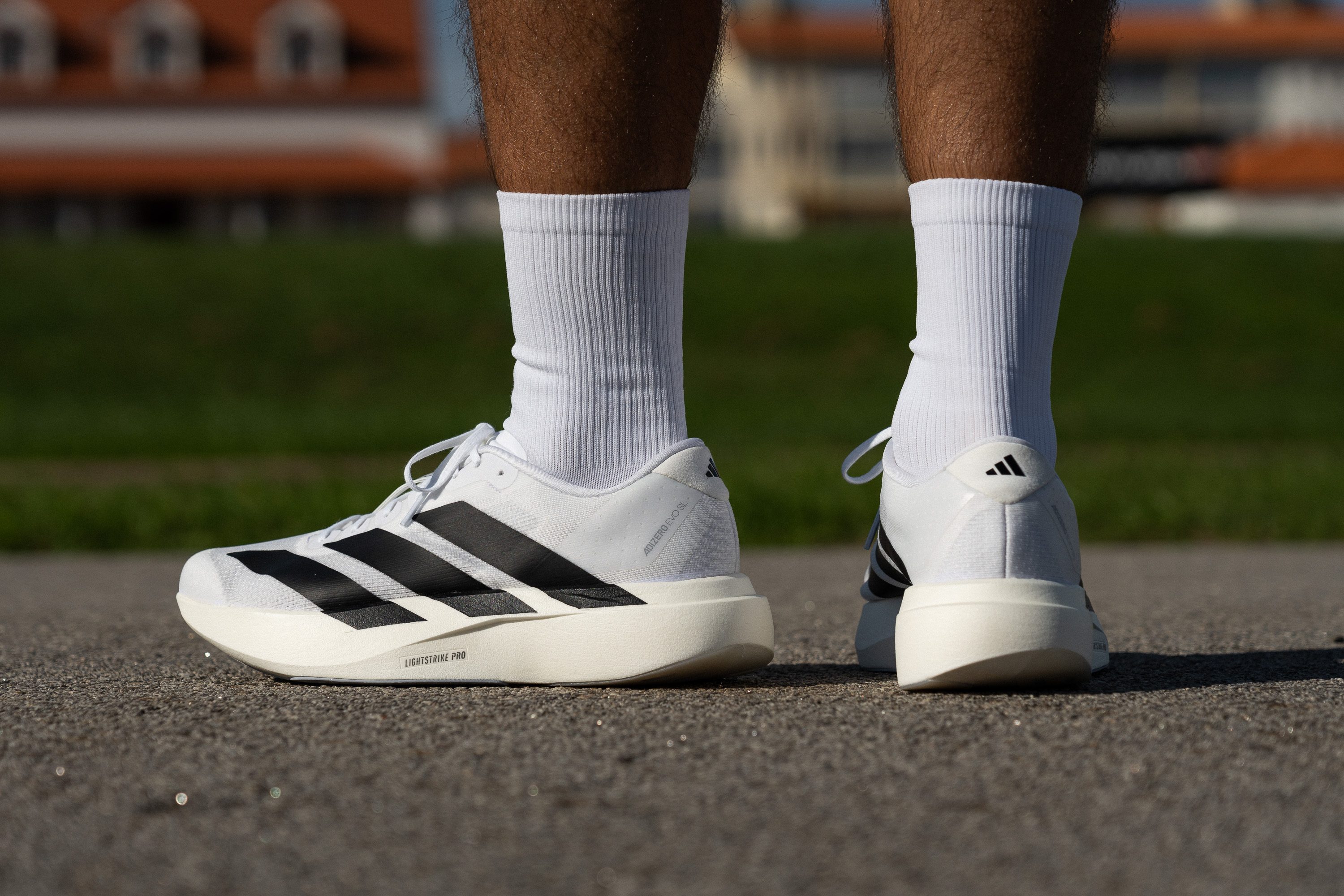
The average weight of tempo shoes is 2.4 oz (68g) lighter than the average of daily trainers!
| Daily trainers | Speed trainers | |
| Average weight | 10.0 oz (283g) | 7.6 oz (216g) |
Tempo training shoes also tend to have bouncier foams and springier rides. We actually measure this in our lab, it's called energy return and tells us how efficiently the midsole rebounds after it has been squished (runners land on it). Looking at the energy return range, daily trainers usually have lower energy return, while tempo shoes and race shoes tend to have sky-high numbers. An energy return of 65% or higher is considered great.
Some tempo shoes even use stiff carbon plates for added propulsion. You can learn more about how plates work in our extensive research. Some speed trainers can also be used for daily training or even competitions.
Race/competition running shoes
This is where you find the world-record-shattering Nike Vaporflys and Alphaflys, Adidas’s buzzworthy $500 Evo 1, among other iconic shoes.
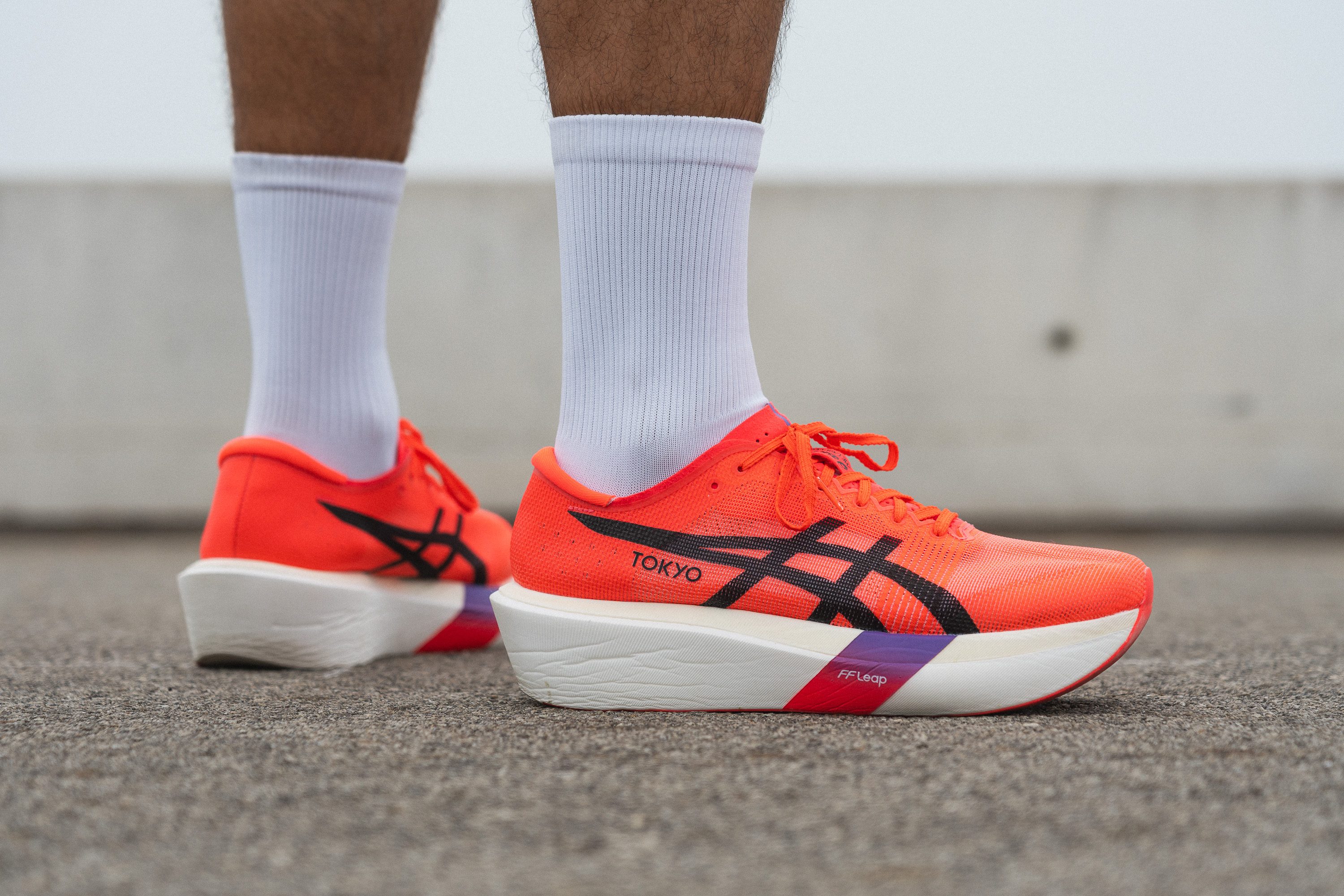
The lightest of running shoes (7.5 oz/213g on average), these racers feature the brands’ most cutting-edge technologies to help you achieve the most efficient performance.
For professional runners, choosing the perfect race shoe gets even more complicated. But it is our mission to help you sort that out. Explore our meticulous guides on foams, carbon plates, rockers, and shoe uppers to get more insights.
Consider the distance as well
A 5K/10K race calls for a much faster pace than a marathon. Your best companion here is a light and springy trainer. Depending on your preference, you can choose between a classic minimally cushioned flat and a super soft and plated maximalist shoe.
Going for a marathon or even an ultra marathon? Make sure you're packed with plenty of cushioning, lasting underfoot support, and a perfect fit.
Some super shoes are so versatile, they can be effective for both 5K and 42K.
Cushioning and ride in running shoes
That slab of foam in between your foot and the ground is what ultimately makes or breaks a running shoe. Getting the following parameters right will guarantee your comfort and best performance:
- shock absorption
- energy return
- stack height
- heel-to-toe drop
- foam softness
- presence of a carbon plate
- presence of a rocker
Shock absorption in running shoes
When we run, we land on the surface, and that feels good because we have our running shoes on. Without them, running, especially at faster paces (and heel striking), would be quite painful because our feet would hit the harsh concrete, and our whole body would feel the impact. Thanks to the lovely foams and high shock absorption, we can enjoy all strikes at all paces, even on the harshest of surfaces.
Shock absorption tells us how much force and impact the midsole can absorb, reducing stress on our muscles, tendons, joints, and whole body. The higher the shock absorption, the lower the stress we experience because the foam dampens the impact!
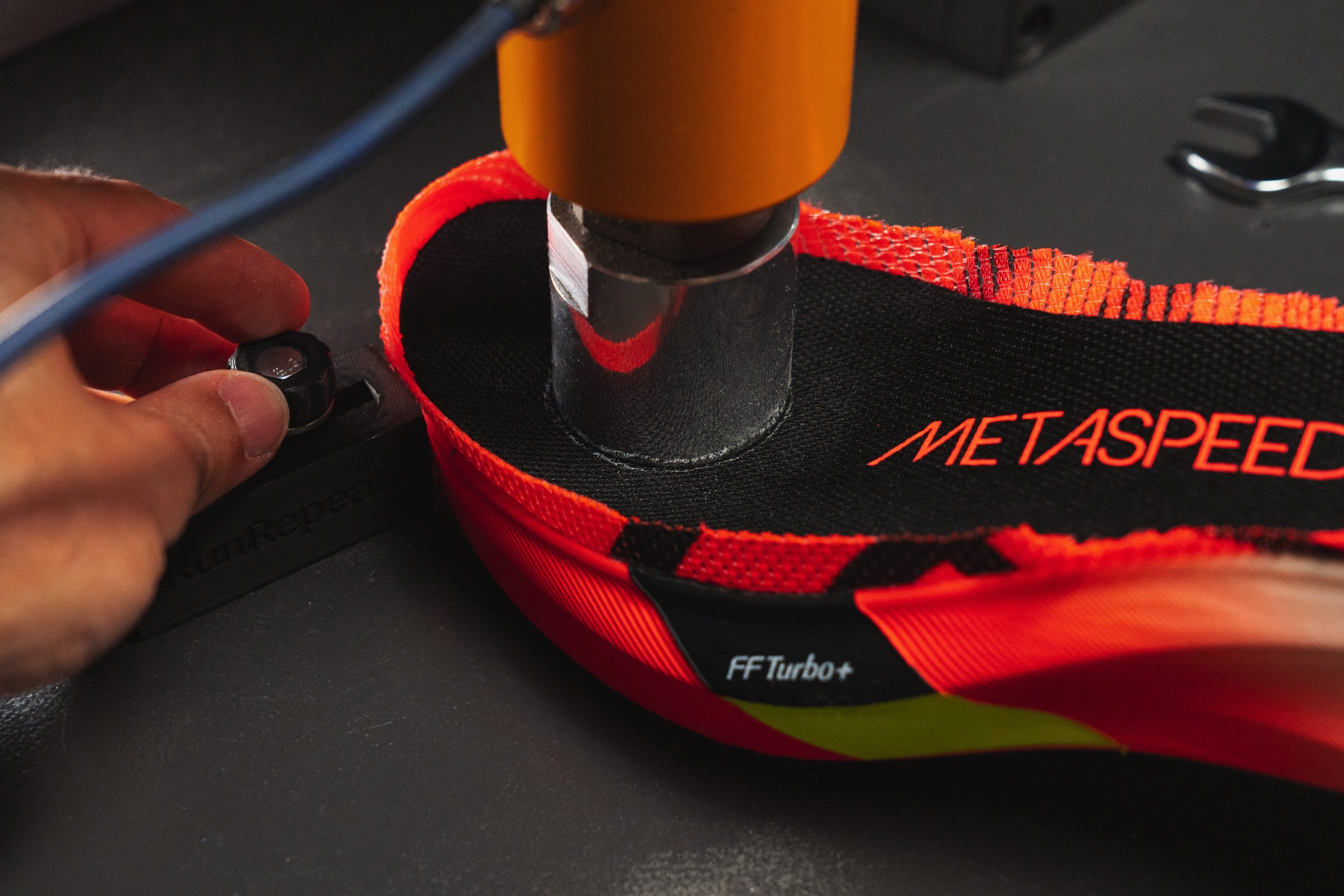
However, many runners who are beginners or recreational, and who have average weight and weekly mileage, opt for moderate shock absorption. This makes sense because there's no reason for them to deal with a potential price increase or a decrease in durability.
If you want to learn more about shock absorption, we recommend reading our in-depth buying guide on shock absorption because it covers all the details you may be interested in as a beginner or as an avid runner.
Energy return in running shoes
Shock absorption and energy return often go hand in hand, however, they are not directly related to each other. Energy return tells us how efficiently the foam bounces back after runners land on it. The midsole is squished and we can see that it returns to its original state (height) or close to it.
The higher the energy return, the less the runner's legs have to work. If you want the best of the best, meaning race-day running shoes that are the most explosive, it's worth noting that for those to work, you need to find a perfect combination of stiffness, rocker geometry, carbon-plate design and placement, and your running biomechanics. Not all shoes work the same or are made for all runners.
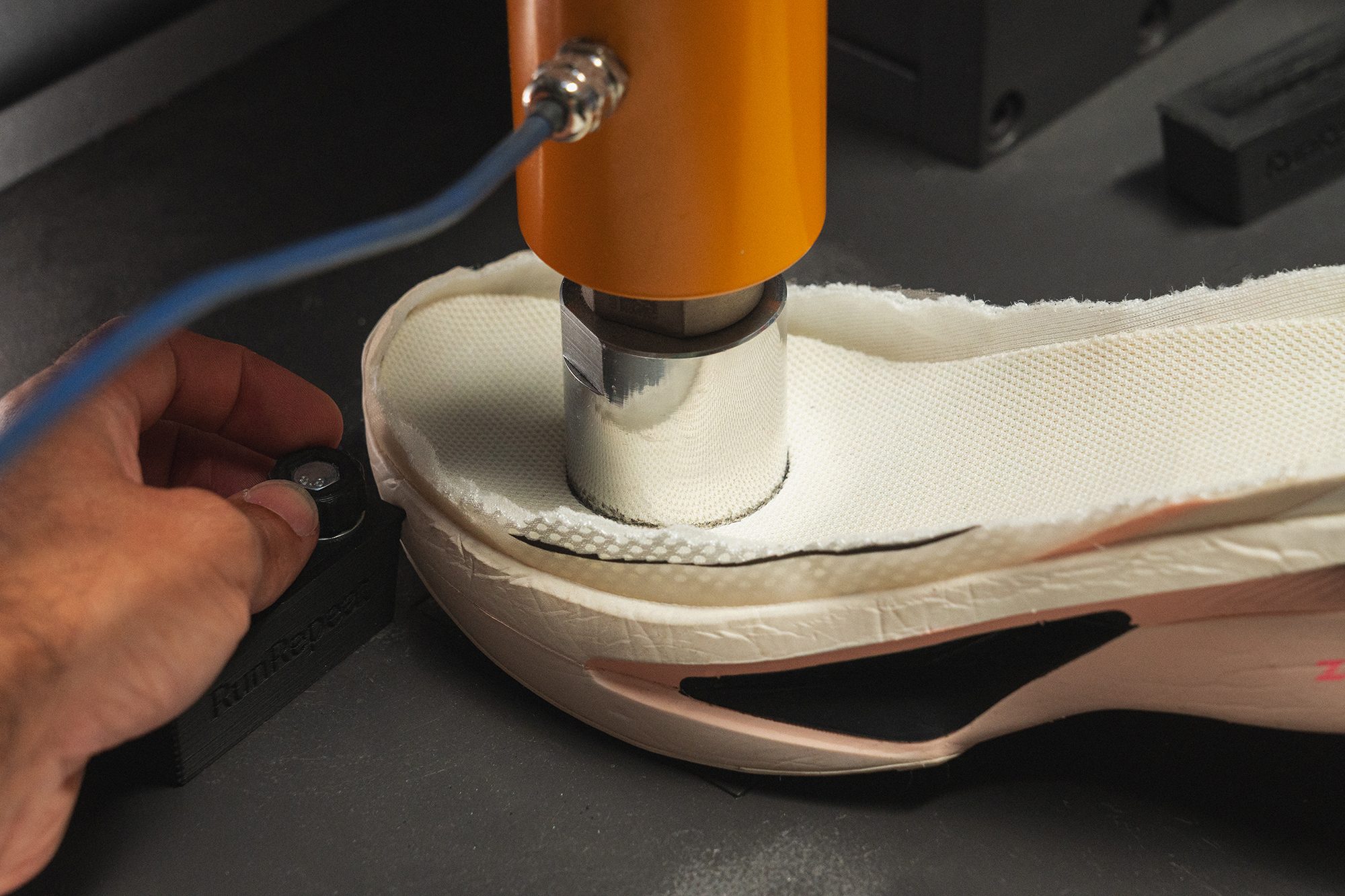
High energy return is often found in more expensive running shoes that feature premium foams. Usually, we're talking about race and tempo shoes.
We actually wrote a very in-depth guide on energy return which covers everything from the very basics to the most nerdy details on foams, lab data, and all the factors that have to play along for a shoe to be as explosive as expected. Read it here: Energy return in running shoes explained.
Stack height in running shoes
Stack height refers to the amount of material between your foot and the ground. We cut each tested shoe in half in our lab to measure its heel and forefoot stack heights following the rules set by World Athletics (at 12% and at 75% of the inside length of the shoe).
First, we mark the exact spots (12% and 75% of the internal shoe length). Then, we measure the heel and the forefoot stack height with a digital caliper
For beginners, we recommend going for heel height in the 28-35 mm range. These shoes are neither too flat (low to the ground) nor too high.
If you need tons of cushioning, go for the 35-40 mm range. Keep in mind that 40 mm is the maximum heel stack allowed for competitions by the World Athletics. Anything above means disqualification.
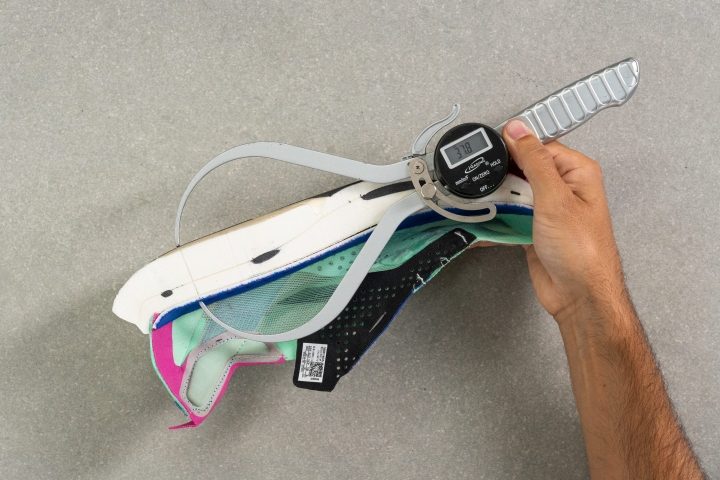
Some seasoned runners also prefer to go down the minimalist and even barefoot path. These shoes have a heel stack of 20 mm or less and require an adaptation period as they activate different biomechanics.
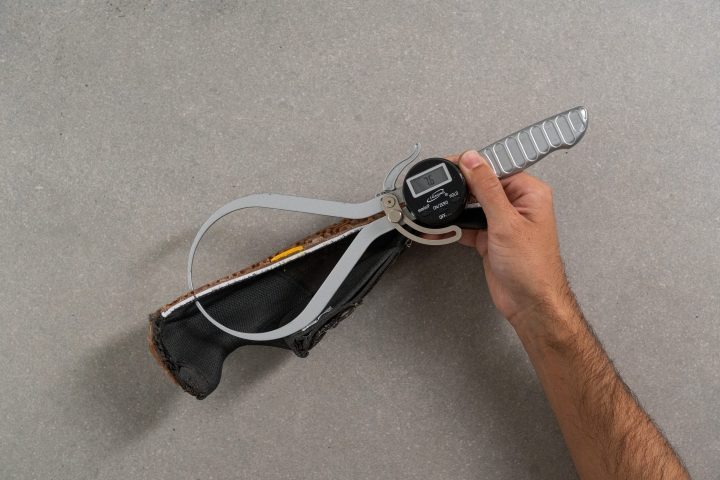
Heel-to-toe drop in running shoes
If you’re new or if you run less than 10 miles per week, there’s no need to know about heel-to-toe drop as long as you buy shoes with at least 6 mm drop (preferably 8-12 mm).
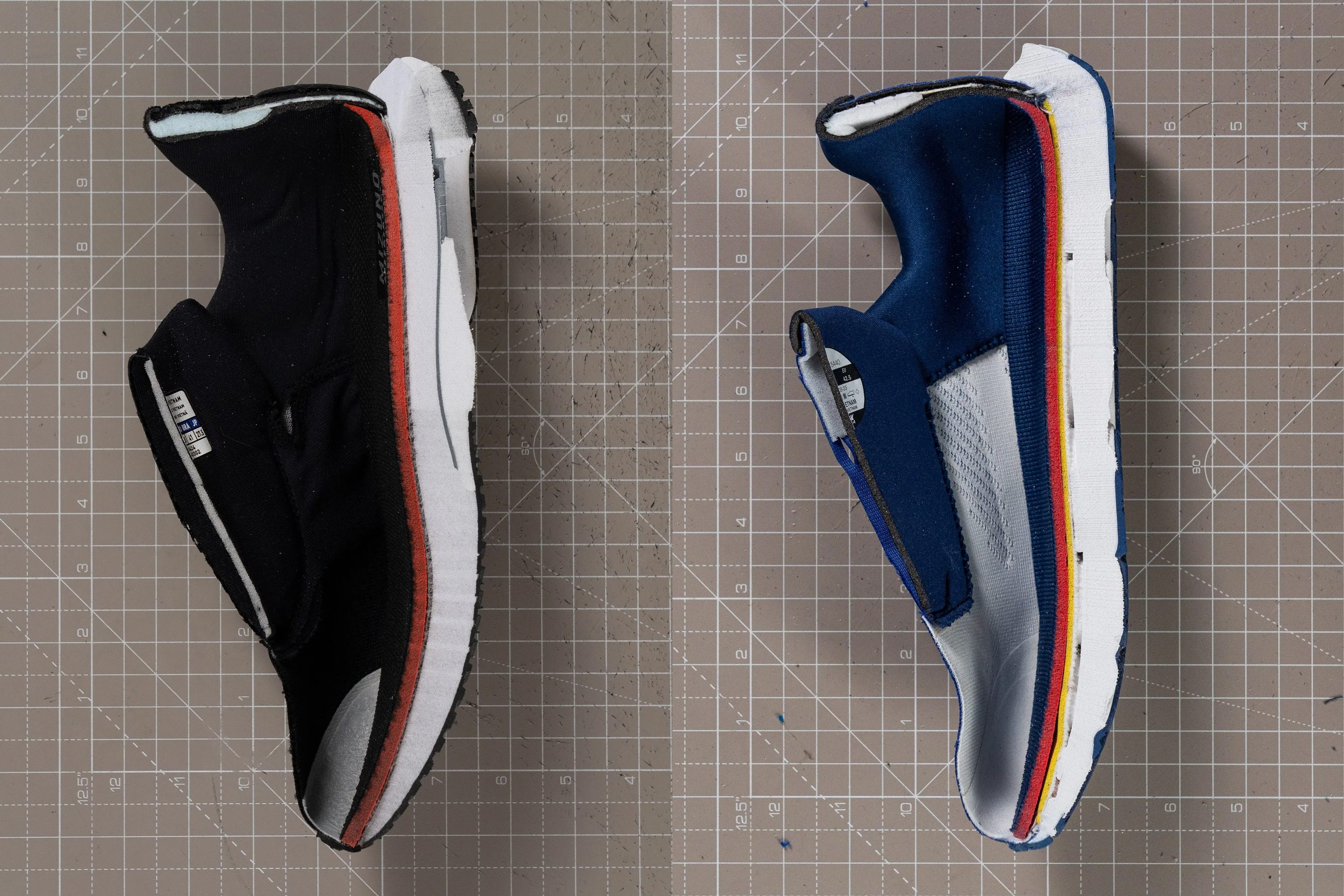
The only exception is if you have a record of severe ankle, knee, hip, ITB, Achilles, or plantar fasciitis injuries. In such cases, seek out a specialist before buying running shoes.
More experienced runners tend to show interest in the heel-to-toe drop. There are a lot of opinions on the subject. If you want to learn more, check our in-depth scientific guide to heel-to-toe drop.
| Heel drop effects | |
|
Low
|
High
|
| The lower the drop, the greater the potential to improve cadence. | Foot switch is slower in higher drop shoes. |
| Lower and zero drop shoes promote midfoot and forefoot strike. | A higher drop allows for rearfoot strike because the elevated heel helps with high impacts when the heel hits the ground. |
| Lower heel drop might help with ITB, (anterior) knee pain, gluteal overuse syndrome. | Higher heel drop might help with plantar fasciitis, Achilles tendinopathy (stiff Achilles), calf injuries. |
| Low drop shoes allow for more ankle flexion during landing. The ankle absorbs the impact and works as a spring. These shoes can place greater stress on the foot, ankle, lower leg. | High drop has a higher knee flexion moment. This means it has the potential to load hips and knees more, similar to heel strike. |
| Overstriding rearfoot strike might be prevented with a lower drop. | Overstriding forefoot strike might be prevented with a higher drop. |
Foam softness
As a beginner runner, you want a balanced type of cushioning that's neither too plush nor too firm. These shoes also work for most runners, walking a fine line between comfort and performance. This type of cushioning is used in the "workhorse" shoes used for daily running and faster workouts.
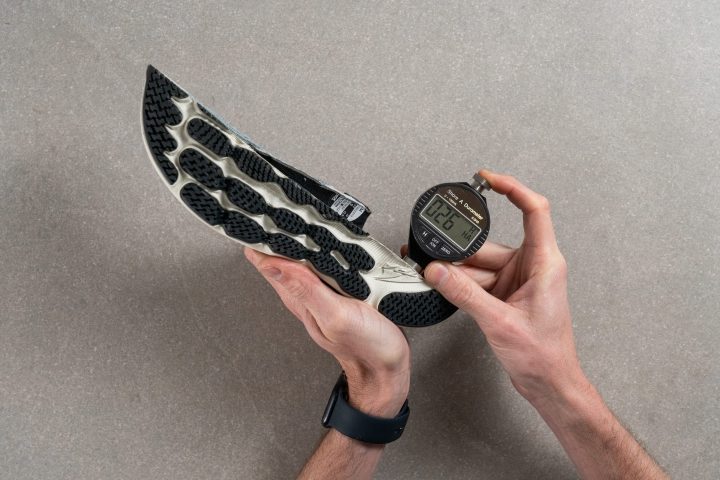
To help you know exactly how soft each running shoe is, we use an HA durometer in our lab to measure foam softness. The lower the number on the tool, the softer the foam. The average durometer measurement for running shoes hovers around 20 HA.
It's important not to confuse softness with shock absorption mentioned above. Softness tells us just that: how soft the midsole is. Shock absorption, on the other hand, tells us how protective the foam is, which, on long runs, means more comfort and less fatigue.
Example of a very plush foam (9.8 HA)
Lower-stacked and aggressive-looking, firmer shoes are best for quick transitions. Studies show that greater midsole hardness in running shoes results in shorter contact time. But keep in mind that there is less shock absorption here. On the bright side, firmer shoes tend to be stable enough to double as gym shoes.
Example of a very firm foam (34.4 HA)
If you want more data-backed insights into choosing between soft and firm cushioning, see our in-depth guide on the topic. Especially if you're wondering how shoe foams behave in the freezer!
Carbon-plated running shoes
If you are a beginner runner, we recommend staying away from carbon-plated shoes for now. These shoes are most beneficial for races and tempo training as they are intended for maintaining faster paces.
First introduced in the Nike Vaporfly in 2016, carbon plates changed the running shoe game forever. Since then, every men's and women's record on every distance has been broken by runners wearing plated shoes.
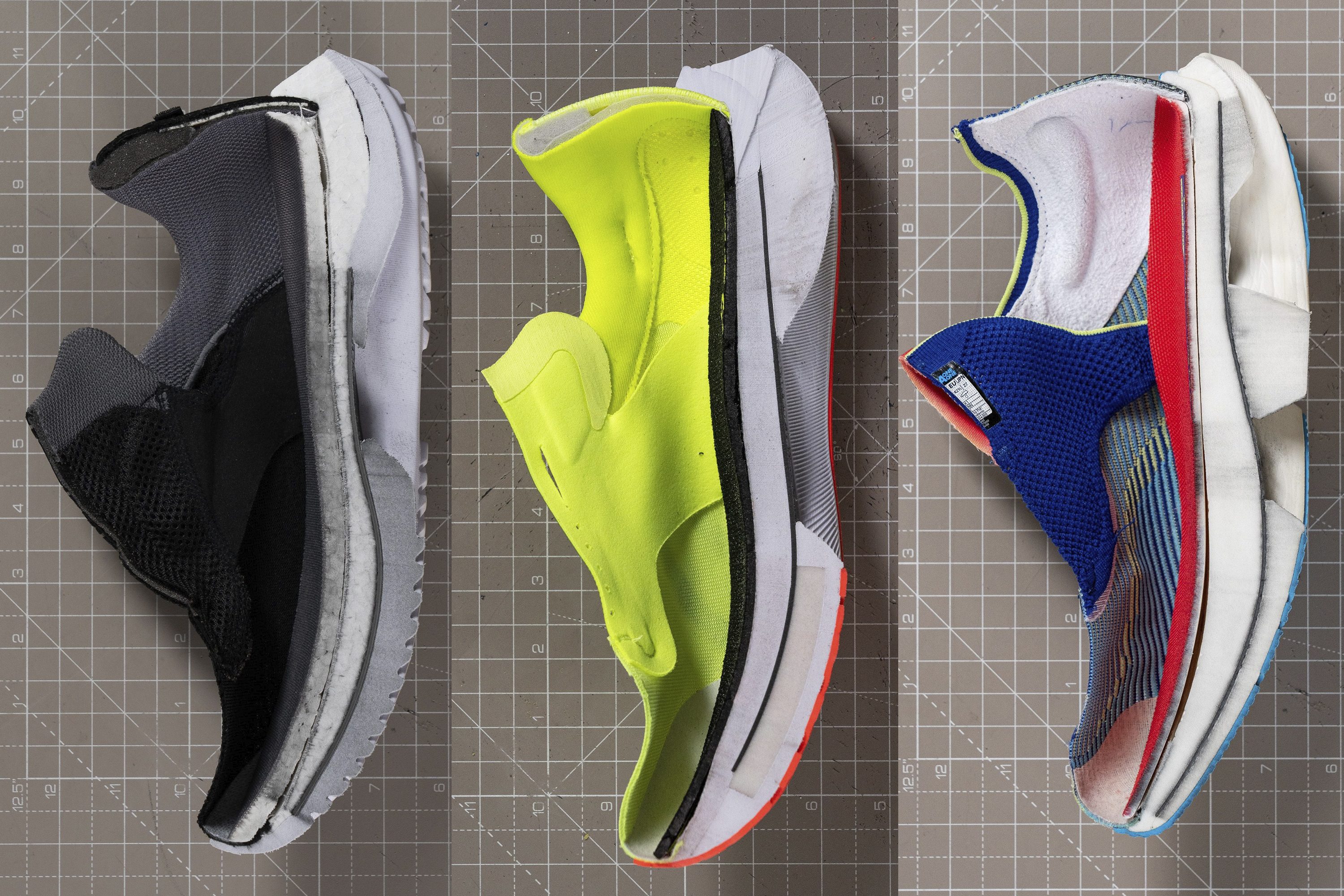
A stiff carbon plate is sandwiched inside the midsole to add propulsion upon take-off. Kind of like a swimming pool springboard.

We dive deeper into the topic of carbon-plated shoes in our extensive guide backed by science and our own lab findings.
What is arch support and why it matters
If you've never heard about arch support, your ankles don't collapse inwards, and shoes don't have a tendency to wear out more on the inner side, then you can probably skip this section.
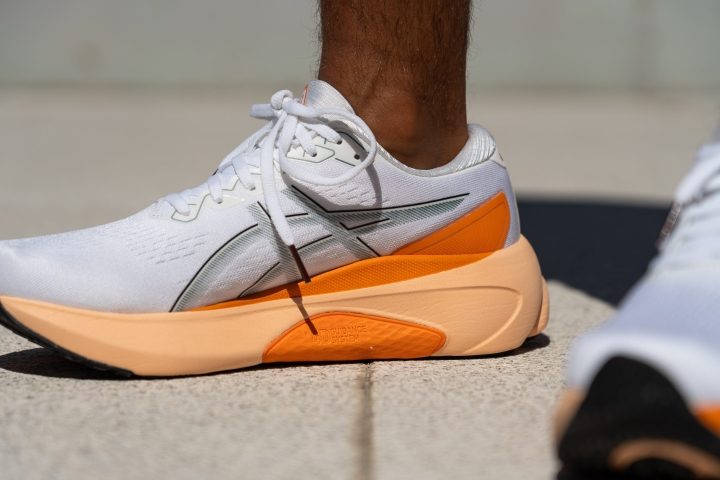
Arch support is necessary when you have flat feet, overpronation, or other foot conditions that call for supportive components in running shoes (like plantar fasciitis). Running shoes with stabilizing technologies are also called stability shoes.
You can see the difference in foot and ankle stability between a neutral shoe (above) and a stability shoe (below) in our lateral movement test.
Here are a few rough guidelines:
- If you don’t know anything particular about your feet, buy neutral running shoes.
- If you have a moderate arch and neutral pronation, buy neutral running shoes.
- If you have a high arch, consider neutral running shoes.
- If you have a moderate arch, buy stability running shoes.
To determine pronation, look at your used footwear - do you wear them evenly? If they’ve been worn more on the outer sides, you’re underpronating. If they’ve been worn more on the inner sides, you’re overpronating. Even wear means neutral pronation.
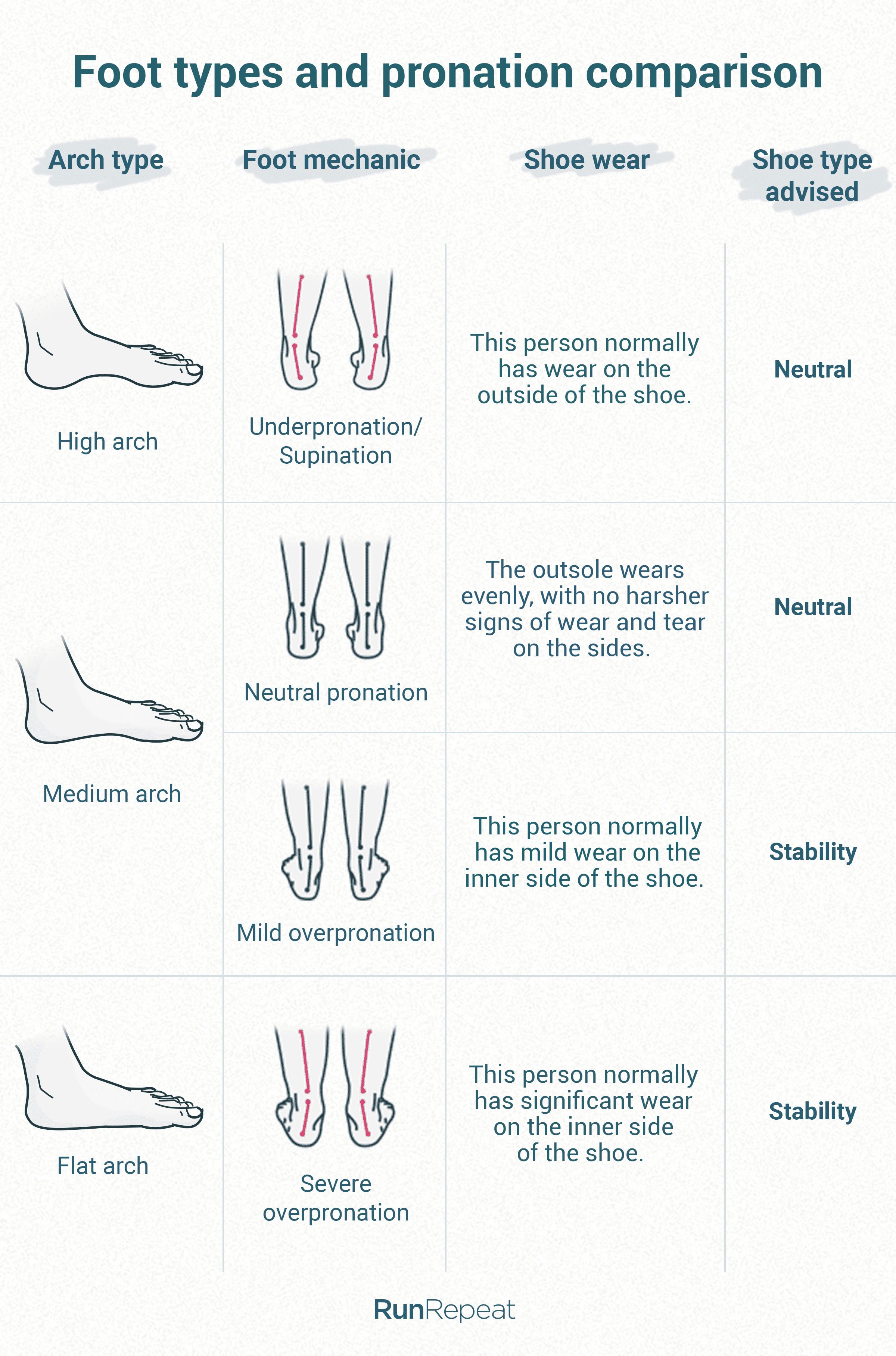
If you want to learn more about arch support in running shoes, we recommend our in-depth guide.
Before we can recommend a stability running shoe, we perform a series of tests and measurements to assess its supportive capacity:
- torsional stiffness (higher rigidity = better support)
- heel counter stiffness (higher rigidity = firmer heel hold)
- midsole width (extended contact points prevent the foot from rolling over)
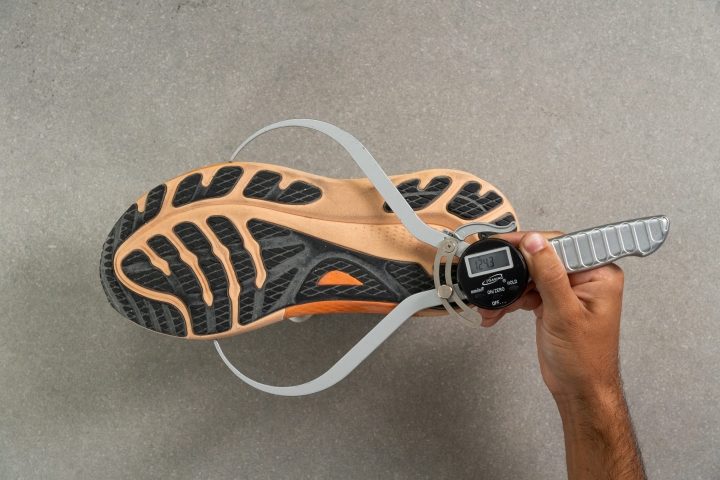
Choosing the right size and fit in running shoes
If it's been a while since you last purchased a running shoe, we highly recommend measuring your foot length from scratch. Too busy for that? Grab an athletic shoe that fits you the best and enter its CM or MM size (i.e. 260, 265, etc.) into this shoe size converter.
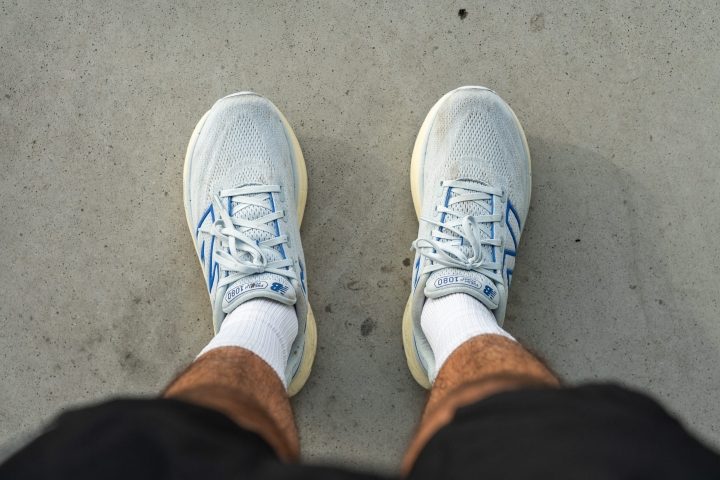
Going with the shoe size you think you have is a risky strategy, as every brand has a different size chart. Even within the same brand, the right size for you may vary from one model to another.
So once you have your precise foot length measurement, do consult the corresponding brand size chart.
In addition to size (length), you must also consider your future shoe's fit. It must not be too tight or too loose around your heel, midfoot, or forefoot. Unfortunately, it's hard to gauge the first two when purchasing online, but we can help with the toebox fit!
To get accurate measurements of the toebox, first, we make a gel mold of the shoe's interior. We do it by pouring our special gel into the shoe and freezing it with the shoe
Once the gel has hardened, we take the gel mold out of the shoe and start measuring.
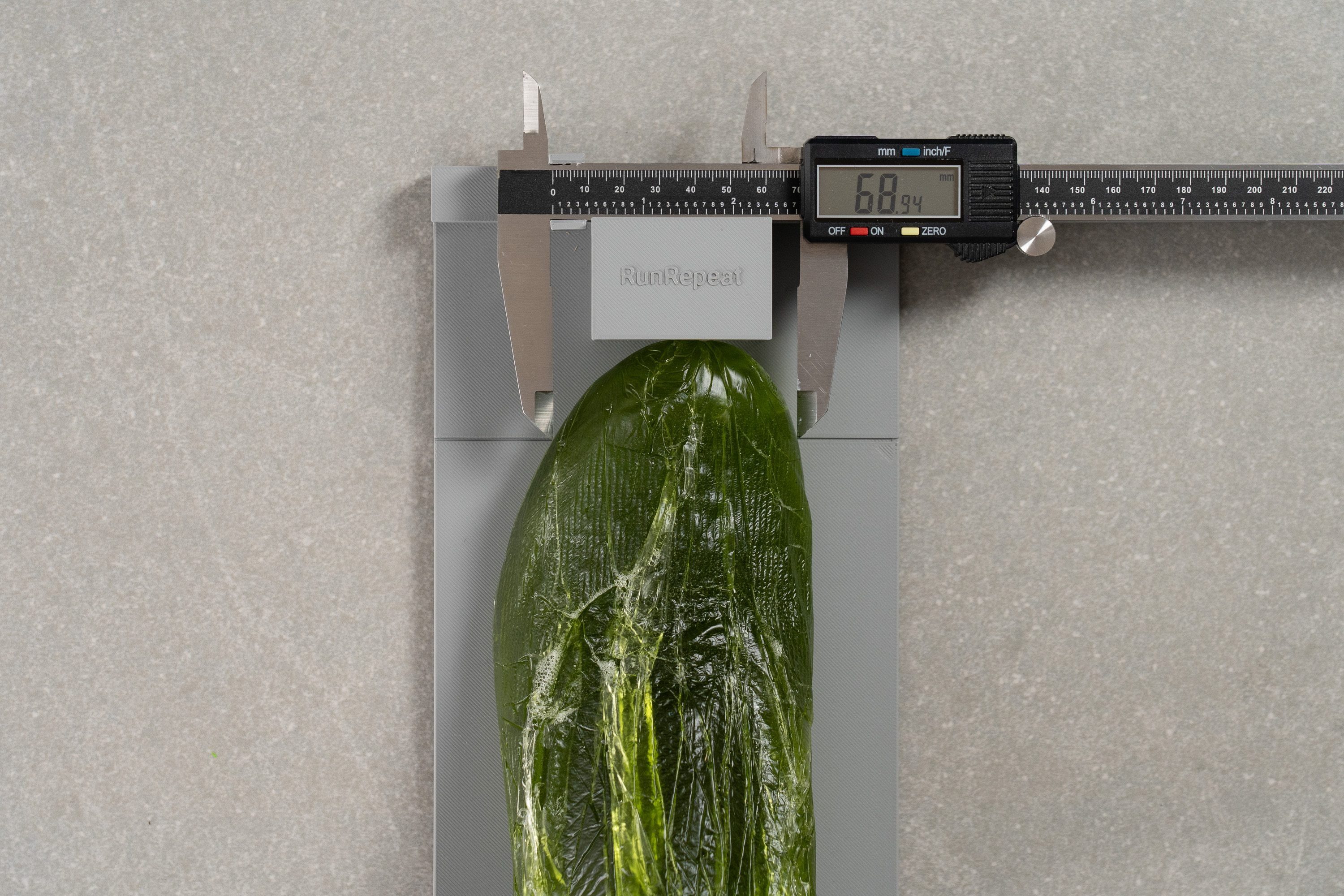
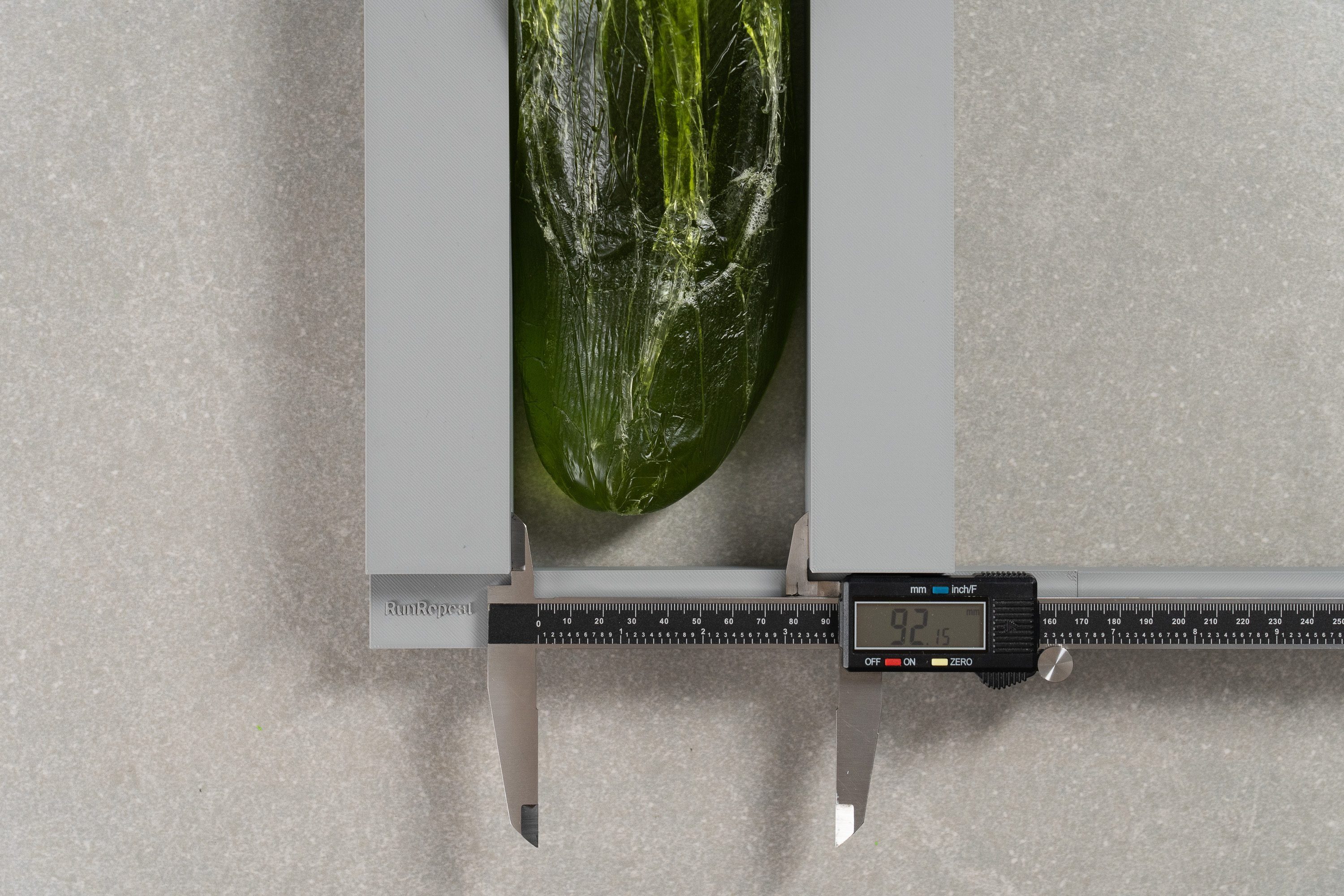
Having both measurements allows us to convey the entire toebox shape as some shoes can be wide enough at the metatarsals but taper aggressively towards the front.
Given that the volume of the feet is not about width only, but also height, we cut our gel mold in half and measure the toebox height.
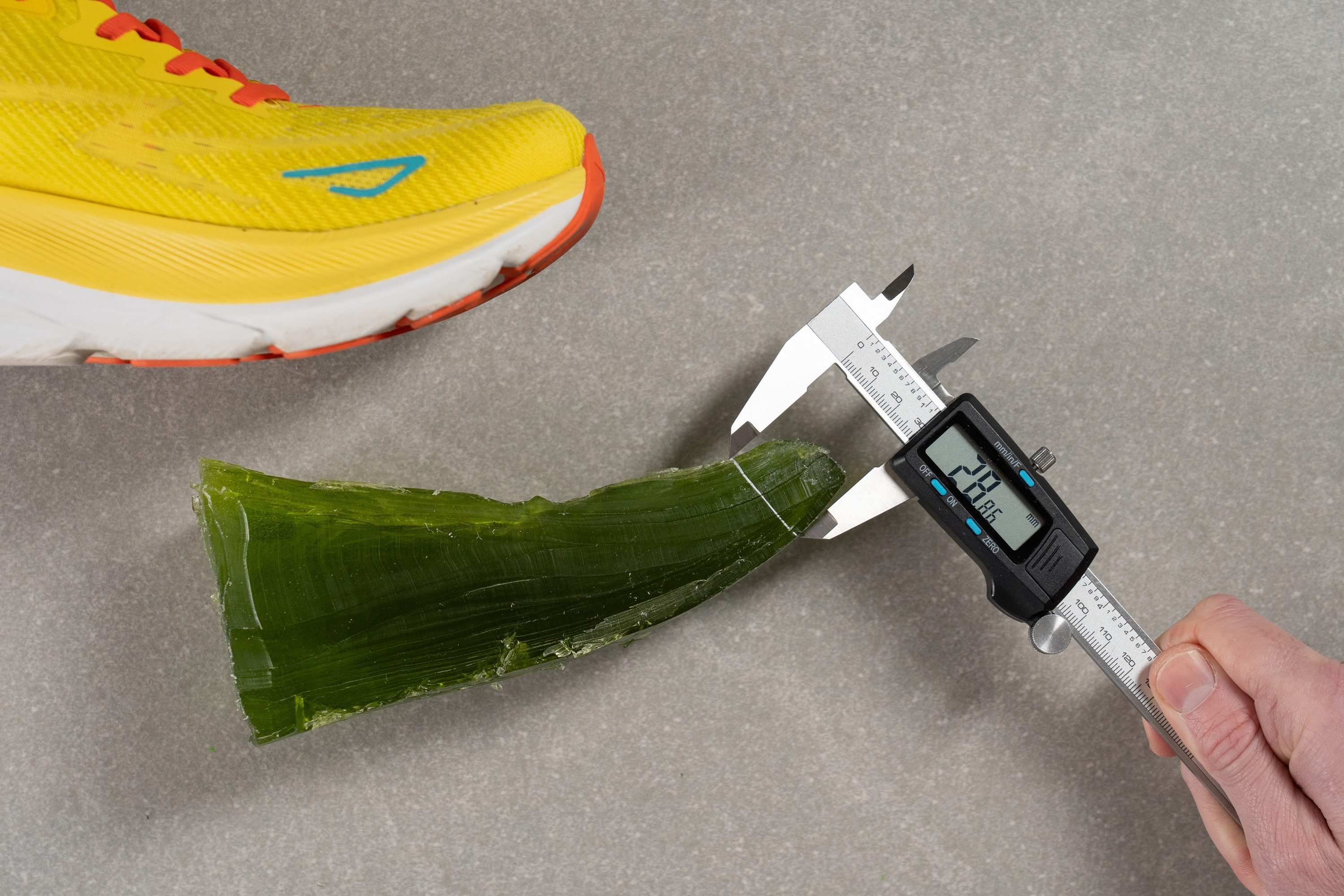
For more nuances on the fit of running shoes, see our guide on choosing the right toebox.
Consider breathability and waterproofing
A vast majority of running shoes are made with breathable mesh uppers which keep the feet fresh. Based on our smoke-pumping machine tests, 60% of running shoes have high breathability scores of 4-5 out of 5.
We assess ventilation by the amount of smoke that escapes through the upper fabric. We then also hover the shoe's half-cut upper over the light to see where most ventilation pores are concentrated.
Waterproof shoes are needed in very rare cases. Only if you regularly run in rainy weather, puddles, slush, and low temperatures. Or if you have multiple creeks or streams crossing your trail. There is a good reason why only 7% of running shoes in our catalog are waterproof.
For winter, you might be just fine getting a non-waterproof pair with a lower breathability score of 1-3.
Traction in running shoes
Many runners don't think about traction, especially if they usually run on dry roads. However, the moment they encounter rain, traction becomes a priority. Because of this, we actually perform the test in wet conditions in our lab.
The higher the numbers on the display (we actually measure a dynamic coefficient of friction here, CoF), the better the traction.
There are other elements you should consider if traction is your priority. For example, the durability and the thickness of the outsole. In very non-durable cases, you will "eat" the outsole prematurely and end up running on exposed midsole, which is the worst-case scenario. You should also consider the rubber coverage, if you're landing on the heel and the shoe has most of its rubber focused on the forefoot, you are not in for a treat. What can you do? Learn more: Running shoes with the best traction.

